Side Menu:
Titanic: Facts & Fallacies
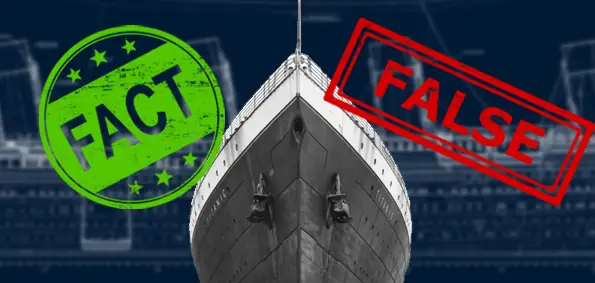
Latest update: 04 October 2024
The Titanic story has something for everyone and in so doing entranced generations for more than a century. This has resulted in the creation of a large number of myths and legends that have no grounding in fact. This regularly updated page endeavours to establish known facts and fallacies involving the Titanic, with a quick access menu so it can be linked to directly.
Any corrections, suggestions or feedback please use the website contact form.
Quick Access Menu:
Overall structure:
A. Main Story
B. Design and Construction
C. Maiden Voyage
D. Disaster
E. Post-disaster
F. Wreck
A. Main Story
1. ”Wreck of the Titan" was not a prophecy
2. The Titanic was not 'switched' with the Olympic
3. Sinking not orchestrated by JP Morgan to stop the Federal Reserve
4. Exact passenger and crew numbers are known
B. Design and Construction
1. Titanic was not financed with US money
2. Titanic was not built with faulty steel or poor quality rivets
3. Titanic was said to be "unsinkable"
4. Titanic's rudder was not too small
5. Titanic had a three bladed centre propeller
6. Titanic had more lifeboats than legally required
7. Titanic was not cursed because it was not christened
8. Titanic was not cursed because its hull number read "No Pope"
9. Titanic was both RMS Titanic and SS Titanic
10. You cannot compare the Titanic with a modern cruise liner
11. Titanic's fourth funnel was not just a "dummy"
12. "Not even God could sink this ship" incorrectly attributed
13. Higher or sealed watertight comparments would not save the ship
14. Search lights would not have helped
C. Maiden Voyage
1. "Jenny" the cat departing with kittens is unverified
2. It was not necessarily Captain Smith 's last voyage
3. Titanic was not fully booked
4. There were cancellations - but nothing unusual
5. There was no cursed mummy in the hold
6. Coal bunker fire had no major role in the disaster
7. Kate Odell's photograph is the last known photo taken of Titanic
8. Titanic was not trying to set a record - but likely to arrive on Tuesday
9. There is no evidence Bruce Ismay forced Captain Smith to go faster
10. A cancelled boat drill on Sunday would not have had any effect
11. Captain Smith and his officers did not "ignore" ice warnings
12. "Lost" Mesaba message was actually within known area of ice
13. Titanic was not travelling at "reckless speed"
14. Captain Smith did not "turn the corner" late
15. "Missing" binoculars would not have changed the situation
16. Titanic's "shut up" wireless message was not rude
17. Titanic was not sailing at maximum speed prior to collision
D. Disaster
1. A mirage is possible but not the key cause of the disaster
2. Solar storm would have little impact on the disaster
3. Head on collision would not necessarily have been better
4. The "grounding" theory is unlikely
5. There was no steering error
6. There was no full astern order
7. The Captain and his officers were not drunk
8. Captain Smith was not in a daze
9. Titanic was not the first ship to use the "SOS" distress call
10. J Bruce Ismay was not a "brute" or "coward"
11. Third class passengers were separated but not locked behind gates
12. Stoker Frank "Lucky" Tower did not survive three sinkings
13. Stewardess Violet Jessop did survive Olympic, Titanic and Britannic
14. Black woman did not die aboard Titanic
15. An officer possibly shot passengers and then himself
16. Distress rockets Titanic fired into the air were not the wrong colour
17. Extra lifeboats would have saved more but certainly not everyone
18. Californian could not have saved everyone
19. The Mount Temple (or the Samson) was not the "mystery ship"
20. The last song was most likely Nearer My God to Thee
21. The Titanic was openly reported as splitting in two
22. There was no heroic dog called Rigel
23. No one could have survived on the iceberg
24. The time difference when Titanic sank
25. John Jacob Astor was not crushed by a funnel
26. Closing portholes would not stop the ship from sinking
27. Being drunk did not ensure baker Joughlin's miraculous escape
E. Post-disaster
1. "YAMSI" message was not Ismay trying to escape
2. The most likely photograph of the iceberg was from the “Bremen”
3. Titanic's lifeboats disappeared after December 1912
4. Titanic's lifeboats were not put on the Olympic
5. Titanic Inquiries were a whitewash
6. Third ship unofficially "Gigantic", officially "Britannic"
7. Lightoller was not a "war criminal"
8. The Titanic officers did not exepience a "stigma" in their careers
9. Titanic was not the main contributing factor to White Star's demise
10. The scrapping of the Olympic was inevitable
11. A violin auctioned in 2013 is most likely Wallace Hartley's
12. "Titanic II" is unlikely to ever sail; Romandie is in dry dock
13. The 1997 film is not exactly the same duration as the sinking
14. The 1997 film was more expensive than building the ship
15. The 1997 film does not make First Officer Murdoch a "villain"
F. Wreck
1. The exact location of the wreck site is established
2. The Titanic was possibly discovered before 1985
3. The Titanic discovery was part of a undercover Navy operation
4. Shoes are not necessarily where bodies lay
5. Wreck cannot be raised
A. Main Story
1. "Wreck of the Titan" was not a prophecy
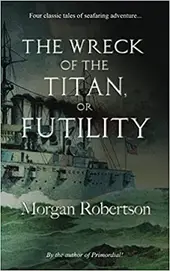
Much is often made of a 'prophetic' story released 14 years prior to the sinking. First and foremost, the author, Morgan Robertson did not call himself a psychic or a prophet. He was simply an American author of short stories and novels and as the son of a ship's captain it is not surprising that he wrote a short novel about a ship called the "SS Titan" in 1898 entitled "Futility, or the Wreck of the Titan".
There are indeed many similarities -the ship is deemed unsinkable, carries insufficient lifeboats, hits an iceberg in the North Atlantic in April resulting in a large loss of life. However what few are quick to point out are also the many differences - for example Robertson's ship has a paddlewheel as well as auxiliary sails, and was on its third (not maiden) voyage. Instead of an iceberg collision on her staboard side, the "Titan" ran up onto a gradual slope of ice until almost completely out of the water, before sliding back into the sea and sinking. Of the 3000 passengers who sailed on the "Titan", only 13 survived. "Titan" was also a popular name at the time, and Robertson clearly knew shipbuilding trends and made some reasonable guesses. In another book about submarines he wrote about early use of a "periscope" which shows he was keenly interested in new technology. But it is also of note that he changed some details in the book post-Titanic disaster, realising that there was profitability in the similarity.
Back to Top menu2. The Titanic was not 'switched' with her sister the Olympic
A sadly very popular but deceptive conspiracy theory, is that the Titanic was swapped with her older sister ship the Olympic in an elaborate insurance scam. Firstly, it must be said that the Titanic sinking was no different than a jet plane crash today (Titanic was the equivalent of a jet liner today i.e. used in the mass transportation and cross continental immigration of people - it was not a "cruise" liner). As is widely accepted by airlines, there is no such thing as a "good crash" for airlines - and neither would there be for the White Star Line. A simple fire would have sufficed - and be far easier to execute.
But more specifically, this claim is patently false for several key reasons:
1. There was no financial motive as the White Star Line partly self-insured their ships and was in profit at the time
2. The wreck has been positively identified as the Titanic - it has her name, builder's ID and her unique design all testify to her as 100% Titanic
3. There is no evidence of a 'switch' - no document, photograph or eyewitness testimony despite the mammoth task involved considering the large number of major and minor structural differences.
4. There are many false claims made about the 'switch theory -mostly incorrect photograph interpretation - which have been exposed and debunked.
More information here: www.titanicswitch.com
Back to Top menu3. The sinking was not orchestrated by JP Morgan to stop the Federal Reserve
It is claimed in the theory that JP Morgan "killed off" his three main competitors to the Federal Reserve who also happened to be passengers aboard the Titanic - Straus, Guggenheim and Astor - by sinking the ship. There are however 2 key main issues:
1. There is zero evidence of such a plan, despite the fact it would be hugely complex.
2. Astor and Guggenheim did not publicly give their position on the Federal Reserve and Straus was actually in *favour* of it, sinking this theory completely.
More information here: https://www.titanicswitch.com/federal_reserve.html
Also check here Reuters Fact Check team article:
https://www.reuters.com/article/factcheck-titanic-conspiracy-idUSL1N2LF18G
4. Exact passenger and crew numbers are known
It is common for many books and documentaries to state that "705" survived while "1500" died. Neither of these numbers is correct. After extensive research (notably by Phil Gowan, Lester Mitcham, Hermann Soldner) the exact numbers have been ascertained to be:
Total number of people on board – 2,208
Total number of survivors - 712
Total number who perished - 1,496
Incidentally, these numbers are in line with what Captain Rostron of the Carpathia estimated - he calculated 711 survivors. For more information see also the books “On a Sea of Glass” and “Report Into the Loss of the SS Titanic: A Centennial Reappraisal”.
Back to Top menu
B. Design and Construction
1. Titanic was not financed with US money
A common misconception is that the Titanic was built using US money (i.e. via J.P.Morgan or IMM). However author Mark Chirnside's research shows this is false:
"White Star was not supported by IMM's resources. IMM was supported by White Star. Construction was financed through capital raised in the United Kingdom. This article explains in detail how: White Star financed the ‘Olympic’ class ships and others by borrowing the money from largely United Kingdom-based investors, mortgaging its own fleet; White Star borrowed the money, rather than IMM, to take advantage of its stronger financial position and lower borrowing costs; The new ships provided additional security underlying IMM’s own debt, without increasing the money IMM itself borrowed; Dividends paid by White Star from 1908 to 1912 helped IMM meet its debt interest payments."
More information:
https://www.encyclopedia-titanica.org/olympic-titanic-britannic-an-issue-of-finance.html
2. Titanic was not built with faulty steel or poor quality rivets
The phrase "amateurs built Noah's ark, but professionals the Titanic" is supposed to highlight how even professionals can get things 'wrong'. However, those who propose that Titanic was built with inferior quality materials ("brittle steel") or faulty rivets forget several key issues:
1. Her older sister, the Olympic, was built of the same quality materials and survived several collisions and yet had an enviable career until being scrapped in 1935 - in fact she was called "old reliable." Indeed the White Star Line tender, the Nomadic, built from the same materials, still exists down till this day! Author Mark Chirnside also notes: "Not many people realise that the steel used was tested and passed according to the standards of Lloyds classification society, even though White Star liners were not classed at Lloyds. Nor is it widely known that H&W opted for a particularly high specification for the material used in particular parts of the ship such as the rudder."
2. Scientific tests are often inaccurate or biased, or based on faulty or incomplete assumptions. For example Titanic researcher and Navy wreck explorer Parks Stephenson noted about one test trying to prove Titanic's "brittle" steel and faulty rivets the following issues:
* It is stated that Titanic was in freezing -2ºC water from Queenstown to her sinking off the Grand Banks but neglects to show that the Titanic was in the warmer Gulf Stream for most of her journey, entering the -2ºC water in the Labrador Current only 4 hours before the collision.
* There is no discussion on how long it takes for cold to affect the granular structure of Titanic's steel plating to such brittleness, nor any mention of the effect of the 38ºC+ temperatures of the operating boiler room on the inside of the steel plating.
* There is no discussion of the thickness of Titanic's steel and how long it would take the outside cold waters of the Labrador Current to fundamentally affect the ductility of 1"-thick forged steel plating that is simultaneously being affected by hot ambient air on the dry side.
* In my discussions with the professors of the University of Washington Materials Lab prior to conducting my own ductile-brittle experiments on a faithfully-recreated section of a riveted joint in Titanic's hull, their conclusion was that the mixing of temperatures, the thickness of the steel and the short time that Titanic was in the cold current most likely did not alter the molecular properties of her steel plating. Images of the wreck seem to bear this out...there are folds in Titanic's steel plating caused by the impact with the ocean floor that demonstrate the steel's ductility in those cold waters on the day of her sinking.
* Titanic's rivets were not made of "junk" - the historical fact is that the majority of Titanic's hull rivets were made of steel, in addition to the wrought-iron ones used where the pneumatic riveter could not reach, meaning there would be differing characteristics at play.
* All 3 of my tests with riveted seam samples (reproducing the exact pattern used in Titanic at the J-K strake landing) failed to reproduce the so-called "unzipping" effect. When one rivet failed, the surrounding rivets picked up and spread out the load. With a horizontal load imposed on the test samples (as would have been experienced during a side-swipe brush with the iceberg), only one rivet failed, the rest held their strength. Where we experienced a multiple failure of rivets (but not because of "unzipping") was when we subjected the sample to a vertical shearing stress (as would have been experienced in a grounding on the iceberg).
For more information please check: "A ‘Rivetting’ Article" by Rudi Newman:
https://www.academia.edu/2441774/Another_Rivetting_Article..._-_an_Historical_Rejoinder_to_Metallurgical_Studies_of_the_Titanic_Disaster
Other references:
https://titanichistoricalsociety.org/titanics-brittle-steel/
3. Titanic was said to be "unsinkable"
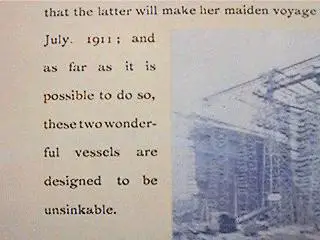
The September 1910 White Star publicity brochure
clearly states that the ships were designed to be
"unsinkable".
There are some who claim that the Titanic was never called "unsinkable" - but that claim is false. The term "unsinkable" or "practically unsinkable" were often used at the time on many ships in both the White Star Line and rival company Cunard prior to Titanic. For example for the Cunard's Mauretania in 1906 - 6 years before Titanic:
"Indeed, the subdivision by watertight bulkheads and decks is the most elaborate that could be devised for a passenger vessel, the number of separate watertight compartments -- 175 -- rendering the ship practically unsinkable."
- The Shipbuilder, Autumn 1906, "The Cunard Liner 'Mauretania'."

The Shipbuilder, Autumn 1906, "The Cunard Liner 'Mauretania'
If Titanic was allegedly "cursed" by being labelled "unsinkable" then why did that not also apply to the Mauretania? Not to mention that the term has been traced back as far as 1903, when the White Star's ship the Cedric was described as having "numerous water-tight compartments that make her practically unsinkable" (The New York Times, Sunday, 8 February 1903, courtesy of Mark Baber)
In regards to Titanic, the reality is that it was referred to as "unsinkable" as early as 1910. For example, the September 1910 White Star publicity brochure that describes the ongoing construction and future amenities of both the Olympic and Titanic includes the sentence on page 4: "these two wonderful vessels are designed to be unsinkable."
For more information and further references please see George Behe’s “How the Titanic Became Unsinkable” at http://wormstedt.com/GeorgeBehe/page2.htm
Back to Top menu4. Titanic's rudder was not too small
The claim that Titanic's rudder was too small is often used in an attempt to attribute blame to her design. Actually her rudder was not too small, both in terms of its comparison to other ships of her size and also as borne out by her sister the Olympic which did not have her rudder replaced or altered after the Titanic disaster and went on to have a very successful career.
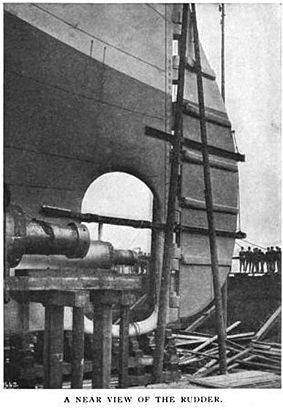
The Olympic's rudder braced for
launching day.
Titanic author and researcher Jonathan Smith states: "The rudder, or lack of a decent size rudder, is a myth. Titanic's turning circle was aided by both the rudder and her hull size. Olympic had exactly the same set-up as Titanic and both ships passed tests which were carried out by the Board of Trade. Even Olympic out-manoeuvred enemy attacks during the war with that same rudder set-up…. I trust Olympic's 24 year career as confirmation the set up was reliable and worked…. The only basis people use that the rudder was "too small" is due to what happened to Titanic. It wasn't brought up beforehand. The fact of the matter is that people scrape the bottom of the barrel to find a cause for blame. The rudder being "too small" is one. They forget to mention that the rudder was attached to a hull that was 850ft in length at the waterline moving through water at 26mph with a displacement of tonnage exceeding 50,000+.The Olympic-class rudder appears to have a little more surface coverage compared to the rudders of Mauretania and Lusitania and their stern and propulsion design."
Another Titanic author Samuel Halpern notes that Captain Smith said the Olympic steered "very well" but also a difference in size could have resulted in an entirely different outcome: "If Titanic's turning response time would have been slightly shorter than it really was, then the bow would have cleared the berg causing the berg to strike further aft, probably opening up multiple compartments in the machinery sections, thus creating an instability leading to a significant list and eventual capsizing."
More information: https://www.encyclopedia-titanica.org/titanic-rudder.html
Back to Top menu5. Titanic had a three-bladed centre propeller
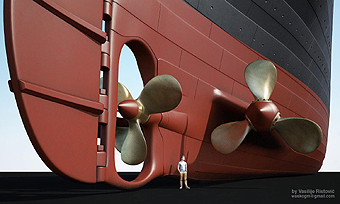
Titanic's centre propeller as visualised by Vasilije Ristović.
For many years it was assumed that Titanic's centre propeller was 4 bladed, simply because photographs of the Olympic showed her centre propeller had four blades. There is no photograph of Titanic's centre propeller. However, the Olympic was the exception, almost all other ships of the time had a 3 bladed centre propeller. Recent research and discoveries made by authors Mark Chirnside and Sam Halpern have confirmed that Titanic's centre propeller was indeed three bladed.
Mark Chirnside concludes: "Essentially, H&W’s own records state that Titanic had a 3-bladed centre propeller. (There’s no evidence for 4 and no conflict of evidence: 4 was simply an outdated assumption which became accepted as fact over the decades before the H&W evidence was available.) As human beings, we’re all subject to familiarity bias. In other words, we only demand photographic or other additional proof of a 3-bladed centre propeller because of the existing belief to the contrary. The evidence we have is very clear."
Bill Sauder explores this question here (YouTube video): https://www.youtube.com/watch?v=D92IKrURvmg
Here is a dossier with the evidence: https://www.markchirnside.co.uk/TitanicThreeBladedCentrePropeller.html
Other references:
http://www.markchirnside.co.uk/TitanicThreeBladedCentrePropeller.html
https://www.encyclopedia-titanica.org/mystery-titanic-central-propeller.html
https://www.encyclopedia-titanica.org/titanic-centre-propeller-new-evidence.html
https://www.titanicology.com/Titanica/ObjectOnTheBarge.pdf
6. Titanic had more lifeboats than legally required
The lack of lifeboats is often referred to as a main cause of the large loss of life and indeed Titanic did not have enough lifeboats to carry the entire complement of passengers and crew. However there are three key points worth noting:
1. Titanic had more lifeboats than legally required. The White Star Line actually exceeded the number required. According to author Mark Chirnside in his article "Titanic's Lifeboats: Fact & Fiction" (2019): "The number of lifeboats was increased between the production of that design concept in July 1908 and Olympic and Titanic’s completion in 1911 and 1912. Another change was that the number of passengers and crew was reduced, so that Titanic’s lifeboat capacity (expressed as a proportion of the maximum passengers and crew she could carry) increased by about 39 per cent. The lifeboats supplied exceeded the requirements of the regulator, the British Board of Trade." Source: https://www.markchirnside.co.uk/pdfs/Titanic_Lifeboat_FalseClaims.pdf
2. Lifeboats for all passengers was not considered necessary prior to the Titanic disaster - it was thought that lifeboats were for primarily transferring people from one ship to another in the event of a disaster, rather than holding everyone aboard at sea. Ships like Titanic were almost always on busy routes where there would be dozens of other vessels nearby at any given time so the concept was that in the event of an evacuation all passengers would be transferred. The Titanic sinking of course changed that mindset.
3. It must also be noted when discussing the alleged lack of lifeboats that not all of Titanic's 20 lifeboats were launched in time anyway - collapsibles A and B were not launched, but floated off the boat deck.
It is also worth noting that the isue of lifeboat capacity was not unique to Titanic. The vast majority of ships prior to the disaster were also grossly lacking in capacity. For an excellent analysis of this please check Mark Chirnside's article "Big Ships and Small Boats (2022)" which analyses the issue, revealing that while the Olympic's lifeboat capacity was a shocking 28% this was actually superior to that of Cunard's Lusitania and Mauretania, and even the Carpathia had only 25% capacity. The lack of lifeboats for all aboard was assuredly not unique to Titanic. For more information please check the article here.
Back to Top menu7. Titanic was not cursed because it was not christened
The documentary-like 1958 film "A Night to Remember" has a memorable opening scene in which the hull of the Titanic is christened by smashing a bottle on the bow. The scene is more surprising considering that the film's producer, William McQuitty, was actually present in Belfast on the 31 May 1911, the day the hull was launched, and remembers watching it vividly, so would have known that no such christening occurred. The lack of such a traditional ceremony has led to the suggestion that it was another reason why the Titanic was cursed. This is not true for two reasons:
1. All of the White Star Line's ship were not christened. Of the 110 vessels that sailed at one time or another under the White Star flag, none that were built specifically for the White Star Line (in contrast to those later bought or chartered) were christened as a matter of course. Harland & Wolff would support the customer's requests and in this case the White Star Line wanted to avoid any superstitious christening. In the case of the Olympic and Titanic their names were well known in advance of the launching of their hulls -certainly by late 1909.
2. Out of all the White Star Line ships built between 1846 - 1932, that were not christened, only a very few sank in circumstances anything similar to the Titanic (for example, the Republic and Britannic), although most of these during wartime. As a particular case in point, the Titanic's older sister ship, the Olympic, also not christened, had a long and varied career during which she was named "Old Reliable" revealing there is no merit to stories of a curse. Additionally, Cunard, which does christen its ships, has not been immune to its own disasters. For many examples check the website Shipwrecks of the Cunard Line.
As a side note, there is an unverified story that on the Titanic's launch day that some of the crowds gathered to watch the hull travel down the slipway overheard White Star managing director, J. Bruce Ismay's American wife, Florence Ismay, quietly say to herselfL "I name this vessel Titanic, and may God bless her and all who sail in her " There is no way to verify such a claim, especially as it is unlikely that in the noise and excitement of the day that anyone could have heard her whisper such a line. Not to mention that as she had been married to Ismay since 1888, she would be unlikely to contradict the custom of her husband's company in such a disrespectful manner. This certainly would not have been her first attendance at the launch of a ship.
Back to Top menu8. Titanic was not cursed because its hull number read "No Pope"
There have been claims that Catholic shipyard workers believed the Titanic was doomed because her hull number read 'NO POPE' backwards. The "No Pope" legend falters on two key facts:
1. Titanic's hull number was not "390904" (the number which viewed as a mirror image spells out "NO POPE"). Her hull did not have a number - her Board of Trade designation was 131,428 and her builders ID, the yard number assigned to her by Harland & Wolff was 401.
2. Virtually all of Harland and Wolff’s workforce was Protestant, not Catholic, and therefore would not have been “spooked” to the point of refusing to work due to a ‘NO POPE’ message.

"No Home Rule" in graffiti on Titanic's starboard hull
The "No Pope" myth may have its origin in the fact that the graffiti "No Home Rule" was written on Titanic's starboard hull in February 1912, aimed at Winston Churchill who visited Belfast in February to give a speech in favour of Home Rule at Ulster Hall. "No Home Rule" was a slogan used by Ulster with the aim to make the possibility of self-government impossible in Ireland. Eventually only the northern part of Ireland - including Belfast - was excluded from Home Rule.
For more information on the "No Pope" myth: https://www.snopes.com/fact-check/pope-and-circumstance/
Back to Top menu9 Titanic was both RMS Titanic and SS Titanic

Titanic lifeboat nameplate shows "S.S.Titanic" (Source: Liverpool Museums)
There are many who claim that Titanic was never "S.S. Titanic" ("Steam ship") but should always be written "RMS Titanic" (Royal Mail Ship). This is incorrect. Titanic was always "SS Titanic" (for example her lifeboats carried that designation: "SS Titanic"). Technically a ship could use the RMS prefix only while contracted to carry the Royal Mail, and if that contract finished would revert to a standard designation such as "SS". So Titanic was only RMS while under contract to Royal Mail. Ultimately she was always SS Titanic. The truth of this is borne out by the fact that all of her lifeboat nameplates were written as "S.S. Titanic" - just in case they lost the Royal Mail contract.
Reference: https://www.liverpoolmuseums.org.uk/stories/carpathias-role-remembered
Back to Top menu10. You cannot compare the Titanic with a modern cruise liner
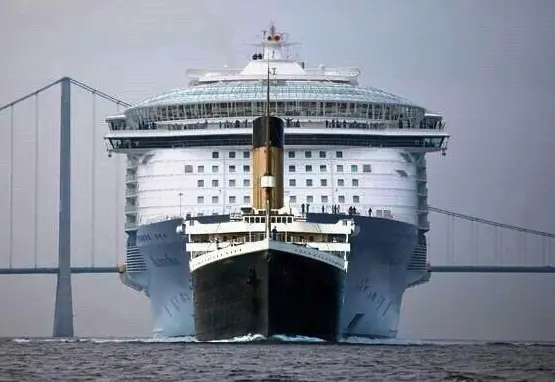
This popular meme is an unfair and illogical comparison
There are two key reasons why a comparison with a cruise liner is unfair and illogical:
1. Titanic was not a cruise liner. She was a passenger liner. There is a clear difference. A passenger liner - much like jetliners of today - are used to transport people internationally. In 1912 this was mostly for immigration and emigration purposes, as well as carrying mail (Titanic was a Royal Mail ship) and cargo. They often work on tight schedules and use main port routes. A cruise ship is not used for general transportation and immigration purposes - it is primarily used as a pleasure cruise, with a less strict schedule and routes determined by scenery and multiple ports of call. This is an entirely different objective to Titanic.
2. The scale in the "meme" is incorrect. The Photoshop artist has not taken distance into account and simply overlayed two images of the ships. In reality, the cruise liner would have to be at least 1000 feet further away from the camera and hence be much smaller than the image suggests. The reality of this can be seen by the size of the people on the cruise ship - if this image was to scale they would be giants.
11. Titanic's fourth funnel was not just a "dummy"
The fourth funnel, or stack, is commonly refered to as a "dummy" with eagle-eyed observers wrongly noting it should not have smoking coming from it. Although it was not connected to the boilers and so would not have smoke coming from the furnaces, the fourth funnel was indeed functional - it was used for ventilation from other areas of the ship such as the engineering spaces. So smoke from those other areas was at times observed being emitted from the fourth stack.
So while having four funnels was likely an aesthetic choice, the fourth funnel did indeed have a purpose. In fact, according to author David G. Brown, "the height, weight, and placement of those huge cylinders had everything to do with the stability and trim of the ship." (Encyclopedia Titanica)
Back to Top menu12. "Not even God could sink this ship" incorrectly attributed
The phrase, "Not even God himself could sink this ship" is frequently quoted as being uttered by passengers, crew or even by Captain Smith himself aboard the Titanic. It certainly entered into the contemporary newspaper articles covering the disaster and later survivor interviews often used it as a phrase to indicate over-confidence. Most of these were many years after the disaster, when the phrase had already entered the vocabularly associated with the sinking. For example, Sylvia Caldwell, a second class passenger, wrote to Walter Lord on July 13th 1955, when he was researching his book, A Night to Remember: "After we came aboard the Titanic we were watching deck hands carrying up baggage I said to one 'Is this ship really unsinkable?' He answered '"'Yes lidy God himself could not sink this ship.' " (Source: https://www.paullee.com/titanic/scaldwell.php).
But notably, this quote from an unnamed crew member did not appear in any of the Caldwell's earlier accounts. Family descedent Charles Calwell points out that "she and my grandfather were very religious people in 1912. They were returning on the Titanic from missionary work in Siam and my grandfather is called Rev. A.F. Caldwell in Washington Dodge's address to the Commonwealth Club. Since they presented their stories "from the pulpit", I would have expected that they would have used this quote as an example of man's folly or arrogance." (Encyclopedia Titanica discussion forum, https://www.encyclopedia-titanica.org/community/threads/albert-caldwell-1965-they-said-that-the-titanic-could-not-sink.20928/page-2)
In reality, it was more likely originally said by an employee of the White Star Line at the launch of Titanic on the 31st May 1911. According to the American National Archives and Records Administration, the origin is thus:
"Not even God himself could sink this ship."
-Employee of the White Star Line,
at the launch of the Titanic, May 31, 1911
(Source: https://www.archives.gov/exhibits/american_originals/titanic.html)
13. Higher or "sealed" watertight comparments would not save the ship
A common misconception is that if the watertight compartments were designed to be higher or sealed at the top the Titanic would not have been completely lost. The problem is a misunderstanding of watertight compartments and the incorrect assumption that the Titanic was not well built or safe, that she was flawed. Actually she was strongly built and exceeded many of the safety standards of the day - including that of the watertight comparments.
By law, a ship of 1912 was required to be able to remain afloat with only one watertight compartment flooded, although the generally recommended standard was that it must be two compartments. In the case of the Titanic specifically, it was designed with a higher margin of safety with the ship designed to remain afloat with any three (or even possibly four) adjacent watertight compartments flooded. All 16 compartments that comprised her hull were also strongly constructed and designed to go as high as E deck - some D deck - and were in addition to a double bottom.

Titanic's 16 "watertight" compartments.
What no designer could have anticipated is an event which would cause not 5, but 6 watertight compartments to be breached - the result of a very unique side swiping of the iceberg, in which the curvature of the ship's hull likely matched the motion curve of her bow as it swung away from the ice, and small apetures being opened to the sea across 6 watertight compartments. Even if it was only 5 that had been compromised it would have still been more than what the pumps could handle, according to testimony by Harland and Wolff's naval architect, Edward Wilding at the British Inquiry in 1912. The reality is that the damage was so serious that the way the ship was designed was simply not at fault.
But what if the compartments were sealed at the top? The reality is that they were capped at the top - by the decks - but not completely watertight sealed, as such is an impossible design for a ship of this sort. The reality is that no ship even today is designed with completely watertight or sealed compartments - not unless it is perhaps a rugged warship or undersea submarine. Although labelled "watertight," the compartments on Titanic were in reality designed to keep water isolated or restricted to within a small portion of the ship, just as they were in the design of ships after Titanic.
Could the watertight compartments not have been higher? Harland and Wolff's naval architect, Edward Wilding, was asked if "no possible arrangement could save the ship?" during the British Inquiry, to which he answered: "No possible vertical extension of the existing bulkheads." Titanic author Sam Halpern concludes that "if the wound came as far aft as BR[boiler room] 5, carrying the watertight bulkheads to D deck would not have saved the ship. If the watertight bulkheads were carried up to C deck the ship might have been saved provided that there was no damage in BR 4. As Wilding said, 'I believe that no bulkhead arrangement possible forward would have saved the ship.'"' This is simply due to the length of the breach across so many compartments.
Some may point out the modifications that were made to both the Olympic and Britannic post-Titanic, including extending the height of the compartments to B deck, as if this indicates there were some flaws in the original design. This is simply not the case - they were improvements based on new information and acknowledgement that they were always exploring more avenues of safety. And more importantly, that still did not stop a ship from sinking, a case in point being the Britannic which sank in less than a hour from a single torpedo in 1916.
So in summary Titanic's watertight compartments did not have a design flaw - they were well designed and constructed and exceeded both legal and standard requirements. What occured was a freak breaching of more compartments than any designer could have predicted.
Further reading: "Practically Unsinkable" by Sam Halpern
Back to Top menu14. Search lights would not have helped
There have been some who have asked why the Titanic was not equipped with search lights - as that would have ensured that during nighttime they spotted the iceberg in time to avoid it. It may seem a reasonable assumption at first. Even Second Officer Lightoller told the 1912 Senate Committee that he thought searchlights "would have assisted us, under those peculiar conditions, very probably. The light would have been reflected off the berg, probably.” Third Officer Pitman also agreed with him. Out of context their agreement is compelling.
The reality is that search lights were not a practical solution for use during navigation. During the British Inquiry, Captain Francis Miller, an Assistant Hydrographer at the Admiralty, was questioned on this point and he admitted that the Admiralty used searchlights more than the Mercantile Marine. In the Admiralty they were used primarily for "picking up buoys and land searchlights...They are also useful in passing through a channel, or through a canal. I submit they are also useful in cases where a ship is stranded...And also for salvage work, and for life-saving." Notably, Miller did not list navigating while in the open sea, and for three clear reasons:
The disadvantages of searchlights, with regard to searchlights on board the ship itself, are that
they may dazzle the officers and the look-out men on board the ship, and in that case specially so, if they happen to be badly placed with regard to the people who are observing. Secondly, they cause a good deal of interference with general navigation, and they would do so very much indeed in crowded waterways. If on the open sea, of course, the objection would be less. The effect of interference on other vessels would be, as is well known, to blind the officers of the watches on board those ships, and, consequently they would make it difficult for them to detect other vessels in their vicinity, and so possibly bring about collision. Thirdly, the lights would have the effect possibly of reducing the brilliancy of the ship’s navigation lights from which the searchlight was being exhibited.
They might also, especially in thick weather and in fog, be mistaken for electric lights of the lighthouses on shore. They also have the effect of screening those shore lights from passing vessels. Another thing with regard to searchlights on board ships might be that a vessel so fitted might depend too much on her searchlights, and get into dangerous proximity to the land and shoal water and buoys, trusting to her searchlights. Further, she might be induced to continue at a high rate of speed, trusting again to her searchlights when, under similar circumstances with regard to weather and so on she would - and rightly so - reduce her speed. I think, too, that the advantages of having searchlights on board ship may not be so great as the disadvantages of causing general interference with the navigation of the ships themselves,
Miller also used a case in point: "One report was received, and the officer stated that in all cases in clear weather the iceberg was sighted before the searchlights picked it up." In conclusion Miller agreed that he thought " it is better that ships of the mercantile marine should be without [search lights]"
Hence it is clear that the use of searchlights would not have necessarily helped - but quite possibly hindered - Titanic's navigation, as the lights would have interferred with the night vision of the lookouts and deck officers, as well as potentially blinded any other ships nearby. Just as a car today does not travel with its headlights on highbeam, or its interior lights switched on, the same applies with vessels at sea. And similar to the use of binoculars, search lights were more of an aid that could be used once an object had been identified.
Back to Top menuC. Maiden Voyage
1. "Jenny" the cat departing with kittens is unverified

"Jenny" the cat is an unverified story that makes for good children's fiction.
There are several legends regarding a cat aboard the Titanic, most popularly named "Jenny" and in some iterations she has four kittens who she takes off the ship just before it departs Queenstown (Cobh), hence predicting its fate.
It was certainly not unusual for a ship to have a cat - they were often employed for their ability to catch mice and rats, so it is quite feasible that the Titanic, on its maiden voyage, would have a cat for such a purpose. There are only two known references to cats aboard Titanic, one from the 1930s and the other, most dubious, from the 1960s:
1. A 28 year old Irish fireman (stoker) by the name of Joseph Mulholland joined Titanic for her delivery trip from Belfast to Southampton, and was tempted to stay for her maiden voyage, when he later claimed to have an uneasy feeling about the ship, due to seeing a cat depart:
Everywhere he has settled for a time Joe always has the company of a cat—because, he claims, “I owe my life to a cat and an old superstition.”
For Joe was on the Titanic when she left Belfast.
“I was leading stoker on the great ship. But I left her at Southampton before she sailed to her doom,” he said.
Before leaving Belfast Joe had taken the cat, “heavy in kitten,” on board.
“She had her kittens on the ship before we got to Southampton, but soon after arriving I watched her carry each one of them to the shore. I thought to myself, if she goes, I go.
And others came with me, too. It was like a rat leaving a doomed ship,” he said.
- Belfast News-Letter, 9 April 1964.
According to the Irish News Global Edition, Mulholland was 'influenced' not to continue his voyage and thought, "That cat knows something and has decided that the Titanic is no place for her or her family to spend their lives." Mulholland then decided to follow the cat's example and left the ship. In another account Mulholland does not name the feline, but instead calls it a "mouser."
It is noteworthy that these accounts are from the 1960s. His earlier accounts from around the time the film "A Night to Remember" was released he indicates he had an argument with an officer and left the ship - not mentioning any cat, casting much doubt on his story. For example, in the Belfast Telegraph of 4th September 1958, Mulholland is quoted as saying that "he was hired as a leading fireman during the Titanic's trials and on her run to Southampton. There he had a dispute with one of the officers and left the ship. Only his argument saved Joe from almost certain death on Titanic's ill-fated maiden run; for most of the stokers aboard lost their lives when the ship struck an Ice-berg and sank." There is no reference to a cat.
2. Stewardess Violet Jessop, wrote in her memoirs in the 1934 which were not published until 1998, in which she named the cat Jenny:
Life aboard started off smoothly. Even Jenny, the ship’s cat and part of the crew, had immediately picked herself a comfortable corner she varied her usual Christmas routine on previous ships by presenting Titanic with a litter of kittens in April. She laid her family near Jim, the scullion, whose approval she always sought on these occasions and who gave her a warm devotion. (Titanic Survivor Violet Jessop, Sutton Publishing Ltd 1998.)
Jessop's story had originally been submitted for a literary competition in the 1930s for which it was presumably rejected.
The story of Jenny and her kittens has found its way into other books and notably into children's fiction. The reality is that there is no verification that Titanic had a cat called Jenny - or even that there were cats aboard (it is known there were dogs).
It is also worth noting that stories of ship cats and premonitions are common and need to be treated with caution. For example, the story of a cat leaving before tragedy strikes (and saving her kittens) likely originated in 1898, during the sinking of the steamship Portland, on November 26, 1898: "A man from Brooklin, Maine, named Gott saw a cat leaving the steamer, taking her kittens down the gangway one by one. He decided the cat knew something he didn’t and got off the boat." ("The Portland Gale of 1898 Wrecks a Ship, Kills 400, Worst maritime tragedy of the 19th century", New England Historical Society)
There are similar stories of "prescient" cats aboard the Lusitania (named "Dowie" who supposedly jumped ship before that disaster in 1915) and Empress of Ireland (named "Emmy" who took her kittens off the ship before its disaster in 1914). The frequency of such stories and the lack of verification for Jessop's account means that "Jenny" the cat may likely be more fiction than fact.
2. It was not necessarily Captain Smith's last voyage
Captain Smith was aged 62 at the time of the Titanic's maiden voyage - although when he signed on he incorrectly stated he was 59. In 1910 Cunard put an age limit of 60 years for captains of their new ships Mauretania and Lusitania. However, this was not a legal requirement. Newspaper reports from 1911 had indicated he was due for retirement. The New York Times of June 6, 1911 reported: "Capt. E.J. Smith, R.N.R. the Commodore of the White Star Line, who is to command the new mammoth liner Olympic, will retire at the end of the present year, it is understood, as he will have reached his age limit. He will be relieved by Capt. H.J. Haddock of the Oceanic."
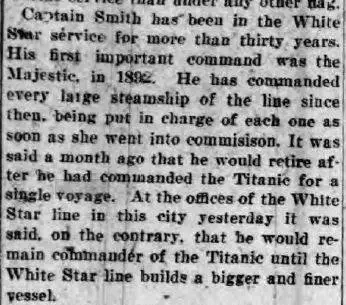
An April 10th, 1912 newspaper report denying reports
Captain Smith would retire after Titanic's maiden voyage.
However the New York office of the White Star Line announced on April 10th 1912,that Smith would remain in command of the Titanic until "a larger and finer vessel" was commissioned, which would have been the Britannic. The Halifax Morning Chronicle, 9th April, 1912 carried the same story, that Captain Smith would remain in command of Titanic "until the company completes a larger and finer steamer."
Hence we can conclude that Smith was on the verge of retirement for at least a year or so prior to Titanic - but he was not necessarily going to retire immediately after Titanic's voyage - that is a "what if" scenario we will never know the answer to. Perhaps Smith had not given the White Star Line his official notice. Or perhaps, since Captain Smith's name guaranteed bookings, the White Star Line might even have encouraged the rumours of retirement, not denying them until the last moment, in order to benefit from bookings by passengers not wanting to miss out on the famous EJ's 'last' voyage.
Back to Top menu3. Titanic was not fully booked
According to research by author Mark Chirnside, Titanic sailed half full: "There was accommodation available in all three classes for additional passengers. Using the best documentation we have available today, thanks to a number of international researchers’ hard work over many years, it appears Titanic had 324 first, 284 second and 709 third class passengers on board for a total of 1,317 passengers. By comparison, she had capacity for 787 first, 676 second and 1,008 third class passengers for a total of 2,471 passengers.2 This means that she sailed with about 53 per cent of her passenger accommodation occupied" ("Titanic: She Sailed Only Half Full?" By Mark Chirnside)
However, as Chirnside explains, there was no reason Titanic would have been fully booked as April was considered a low season for westbound traffic.
Reference: https://www.markchirnside.co.uk/pdfs/TitanicMaidenVoyageHalfFull.pdf
Back to Top menu4. There were cancellations - but nothing unusual
There are claims that "more than fifty first class passengers cancelled at the last minute" often with the implication that they knew something was going to happen, or even more extreme, that they were friends and business associates of JP Morgan, thus tying it into a Federal Reserve conspiracy.
Firstly, there were of course last minute cancellations, as is the norm for the time; similar happened to the Olympic's maiden voyage. However author Mark Chirnside writes: "When the Titanic sailed on her maiden voyage in April 1912, the number of passengers that she was carrying was very similar to the number that was booked onto Olympic for her maiden voyage the year before. It’s natural that there will be cancellations and while more than fifty might sound like a high number it’s hard to see that there is much significance in this fact as regards the switch theory... If a number of people had cancelled because of some sort of fear of a switch or insurance scam going on, it seems very likely that they would have spoken out after the disaster. There is no record of anyone doing so."
There is also often confusion over the crew - with some claiming that a large number of Titanic's crew signed off at the last minute. However this is confused with the local runners from Belfast, who would have returned to Belfast after Titanic's delivery trip, rather than journey on an international route, away from their normal waters.
See also:
https://www.titanicswitch.com/claims.html#20
https://www.titanicswitch.com/claims.html#21
5. There was no cursed mummy in the hold

The "mummy" is still on
display in the British Musuem.
A legend states that the coffin of Princess of Amen-Ra, which had caused a number of mysterious deaths, was taken from the British Museum by an American archaeologist and shipped aboard Titanic. However there is no mention of any mummy in Titanic's detailed cargo list and perhaps even more conclusively the mummy which the story refers is still there in the British Museum to this day.
According to Snopes "this ghost story was concocted around the turn of the century by two Englishmen named William Stead and Douglas Murray... This ghost story made the leap from London to the Titanic after William Stead went down with the ill-fated ship on 15 April 1912... the coffin lid of the Priestess of Amun is still on display at the British Museum, just as it was when Stead and Murray created their infamous “cursed mummy” tale a century ago. Look for exhibit BM No. 22542, in the Second Egyptian Room." (https://www.snopes.com/fact-check/mummy-titantic/)
More information:
https://www.britishmuseum.org/collection/object/Y_EA22542
6. Coal bunker fire had no major role in the disaster
It has been widely known since 1912 there was a coal bunker fire aboard Titanic but it wasn't until a documentary appeared in 2017 (entitled "Titanic: The New Evidence") that there was a resurgence of interest. Despite what the documentary claimed, actually the coal bunker fire had little to no effect on the disaster. Notably a photograph allegedly showing a mark does not align with the coal bunker and even more importantly - there are no other photographs that show this mark in the same position.
For more information on the reality of the coal bunker fire, see here: https://www.titanicswitch.com/coalbunker_fire.html
Back to Top menu7. Kate Odell's photograph is the last known photo taken of Titanic
There have been many candidates offered as the "final photograph of Titanic". However, according to artist and Titanic visual historian Ken Marschall, the photograph below "is the last one known of the ship, taken from a tender heading back to Queenstown by first-class passenger Kate Odell who had just disembarked with her family and others."
Günter Bäbler, the president of the Swiss Titanic Society, agrees with Marschall’s analysis.
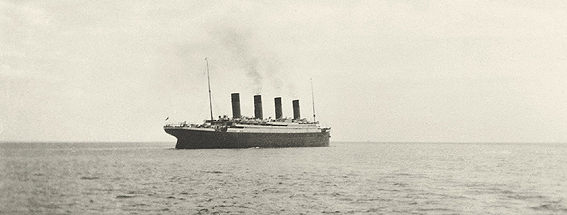
The last known photograph of Titanic was taken by
first-class passenger Kate Odell.
(Click image to enlarge)
More information here: https://www.snopes.com/fact-check/final-photograph-titanic/
Back to Top menu8. Titanic was not trying to set a record - but likely to arrive on Tuesday
Titanic was not capable of setting a record and certainly not the Blue Riband, a metaphorical award for the highest average speed in a crossing of the Atlantic Ocean. Titanic's top speed was 23 knots. Rival Cunard liners the Lusitania and Mauretania could both exceed 25 or 26 knots - so there was no competition. The White Line was aiming for luxury rather than speed.
Additionally, chairman and managing director of the White Star Line Bruce Ismay testified at the United States Inquiry that "we would not attempt to arrive in New York at the lightship before 5 o'clock on Wednesday morning... there was nothing to be gained by arriving at New York any earlier than that." (US Inquiry) However, it is quite possible that they were trying to beat her older sister Olympic's maiden voyage record. Indeed, the facts show that Titanic was being run for a Tuesday night arrival with an average speed of over 22 knots which if maintained would have meant a Tuesday night arrival, although not actually docking until Wednesday morning. See the chapter “She was built for a Wednesday Ship” in Mark Chirnside and Sam Halpern’s article “Olympic and Titanic: Maiden Voyage Mysteries” (https://www.encyclopedia-titanica.org/maiden-voyage-mysteries.html). In the book "Recreating Titanic and Her Sisters: A Visual History" by Tad Fitch, Bill Wormstedt, J. Kent Layton and Ken Marschall, it is concluded based on calculations that if poor weather, fog, or an iceberg had not intervened, Titanic would have reached the Ambrose Channel Light Vessel (the official end point for the Atlantic crossing), at about 11pm on the evening of Tuesday, 16 April 1912. That would mean they would have docked - barring any delays - at White Star's Pier 59, Manhattan, at about 6:30 a.m.
Back to Top menu9. There is no evidence Bruce Ismay forced Captain Smith to go faster
Bruce Ismay was chairman and managing director of the White Star Line and travelled in the capacity of a passenger aboard Titanic. After he survived there was much speculation as to the role he played in the disaster including the insinuation that he persuaded Captain Smith to go faster for an earlier arrival. As already pointed out in the point above, Ismay testified at the US Inquiry that there was no attemptto arrive early and that he had "never" consulted with Captain Smith about the movement of the ship, or he with him, "but what we had arranged to do was that we would not attempt to arrive in New York at the lightship before 5 o'clock on Wednesday morning...But that was arranged before we left Queenstown." (US Inquiry)
A primary source of evidence used to promote the idea that Smith was unduly influenced by Bruce Ismay is a conversation overheard by First Class passenger Elizabeth Lines, who gave a deposition at a liability hearing in November 1913 in which she said she heard Smith and Ismay discussing the "day's run" and most pointedly "We will beat the Olympic and get in to New York on Tuesday.”
However, it must also be noted that we cannot be sure that Lines saw Ismay talking to Captain Smith - while she "knew him [Ismay] by sight" she admitted she "had never seen Captain Smith" before and it was a table steward who told her it was Smith.
The reality of the interaction between Smith and Ismay is pure speculation and likely has little bearing on the matter as it was standard practice to sail at speed anyway - what Smith did was not unusual for the time.
Back to Top menu10. A cancelled boat drill on Sunday would not have necessarily had any effect
Indeed a "drill" or muster for the crew was planned for 11 a.m. Sunday 14th April aboard Titanic but did not take place, for reasons that are unknown although Lookout Archie Jewel later said it was due to the cold wind.
But first, it is incorrect to say that there was no "drill" aboard Titanic - actually there were several, including during her Board of Trade sea trials in Belfast and in Southampton prior to departure. Titanic's officers and crew were involved in these - including on the morning of her departure from Southampton. Additionally, it seems that aboard the Olympic, Captain Smith performed most of this drills while in port in New York on a Sunday.
Second, it is important to note that rather than a "drill" it was actually a "muster" of the crew at their assigned lifeboat stations and did not involve any passengers, so its effect on the actual evacuation that took place later that night is limited. Some of the crew involved in the muster would have been missing, since the stewards would need to look for and rouse passengers, resulting in an entirely different set of crew and circumstances.
More information here https://www.encyclopedia-titanica.org/the-forgotten-drills-aboard-titanic.html
Back to Top menu11. Captain Smith and his officers did not "ignore" ice warnings
A common myth is that Captain Smith and his officers ignored ice warnings. Actually, they had received several messages in the days leading up to Sunday April 14th and had plotted the reported positions. Specifically, Smith received a message from the Baltic that ice lay almost directly in their path in Lat 41° 51'N, 49° 52'W.
Smith and his officers, as with highly experienced mariners of their time, were familiar with operating in the vicinity of ice and relied upon the longitude of the ice area rather than the latitude, and also upon the action of the sea against the ice to give warning in good visibility. Based on this Captain Smith briefed his officers, including Second Officer Lightoller during lunch time on Sunday the 14th that they would be meeting ice. On the night in question, they had calculated they would meet ice by at least 11pm. Junior Sixth Officer James Moody was in fact given the task of calculating the proximity of ice and his conclusions were that they would meet ice between 9.30pm and 11pm. Consequently extra precautions were made. For example, at 7.15pm, First Officer Murdoch requested Lamp Trimmer Samuel Hemming to 'go forward see the fore scuttle hatch closed as we are in the vicinity of ice, and there is a glow coming from that…I want everything dark before the bridge.’ The lookouts in the crows nest were also ordered to keep a sharp lookout for ice.
Additionally, Captain Smith maintained a "southern track" a lane that would normally ensure they were south of any ice, and so likely to avoid anticipated hazards as per the ice messages. But Smith could never have imagined that he would meet with such rare weather conditions (flat calm, no moon, no swell) that would essentially make the iceberg invisible. For that, he cannot be blamed.
Back to Top menu12. "Lost" Mesaba message was actually within known area of ice
There are some who claim, including Second Officer Ligthtoller, that an ice warning from the SS Mesaba was not delivered to Captain Smith and if they had received it disaster could have been averted. However there is no evidence that the message was not received by Smith or his officers as Senior Wireless officer Jack Phillips, Captain Smith and First Officer Murdoch were all lost. Perhaps it was received. And even if it wasn't delivered, the plotted coordinates in the ice message were actually within the known area of ice that Smith and his officers already knew about and had calculated they would reach between 9.30pm and 11pm. The "lost" SS Mesaba message is hence a red herring.
Back to Top menu13. Titanic was not travelling at "reckless speed" - it was normal for the time.
Captain Smith and his officers are often criticised for travelling at almost full speed despite having received ice warnings, but actually this was the norm for the time - but only when the weather was clear and there was good visibility, weather conditions that existed on Sunday the 14th of April. Captain Smith was not the only master to do this - it was common practice. Maintaining high speed was for several critical reasons:
* In 1912 ships such as the Titanic were not cruise ships - they were passenger liners for mass transportation of people and cargo, much like jet aircrafts today, and had strict schedules to keep. Hence, time was of the essence.
* Speed aided manoeuvrability. Long ships such as the Titanic turned faster at speed and so it was considered prudent to maintain speed so as to avoid ice or other obstacles.
* Maintaining speed also meant exiting the danger zoon quicker and thus being exposed to risk for less time.
Captain Smith was not a reckless captain. The two previous incidents (the Olympic-Hawke collision and Titanic-New York near collision) took place when his ship was under compulsory pilotage (Trinity House Pilot George Bowyer was in command on both occasions). And indeed, according to author Mark Chirnisde we have an example of how Captain Smith behaved as the commander of the largest ship in the world on her maiden voyage, from June 1911. On the Sunday, the Olympic encountered fog and was slowed down for a few hours, delaying her 1 1/2 hours in total. If similar had happend to Titanic almost undoubtedly Smith would have slowed the Titanic down.
When Lightoller was told at the British inquiry that it "was recklessness, utter recklessness, in view of the conditions to proceed at 21 ½ knots" Lightoller replied that "then all I can say is that recklessness applies to practically every commander and every ship crossing the Atlantic Ocean."
Indeed we have evidence from other contemporary captains testifying that Smith was adhereing to the norms of his day:
1. Captain John Pritchard, who formerly commanded Cunard's record setting Mauretania, which was capable of 26 knots, said "should only slacken speed if the weather conditions were unfavourable." (The Cambria Daily Leader, 24 June 1913). At the British Titanic inquiry, on day 27, he testified under oath that even with "information that there was a probability of your meeting ice on your course" he would maintain speed: "As long as the weather is clear I always go full speed." Pritchard also explained that this was in his experience a "universal practice" - based on his time commanding Cunard ships between Liverpool and New York for 18 years. He also noted that if following the southern track - as did Captain Smith - he had "never got into an ice-field. We do not go North, you know; we go on the southern tracks this time of year." As for lookouts, he would not double them when in "clear weather." Captain Pritchard on the bridge of the Mauretania, November 1907.
2. Captain Hugh Young, of the Anchor Line, with 37 years experience crossing the Atlantic on the New York trade, testified under oath that if ice were reported, he "should keep my course and maintain my speed" in clear weather. He also confirmed this was a "universal practice" (British Inquiry, Day 27)
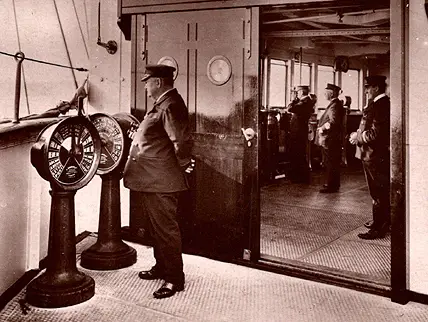
Pritchard and ten other captains testified under oath that they would have maintained speed and not put on extra lookouts in clear
conditions - exactly as Captain Smith. (Click image to enlarge)
3. Captain William Stewart, Canadian Pacific, worked for 35 years on the trade between Liverpool and Canada. He was posed with the question if you "were given information that you might meet ice and that your course would take you through the place where you might meet ice, and meet it at night, would you reduce your speed?" His answer was: "No, not as long as it was clear." He was asked further, "if you had information that you might meet field ice, would you still maintain your speed?" and responded similarly: "Until I saw it, and then I should do what I thought proper." "(British Inquiry, Day 27)
4. The evidence of Pritchard, Young and Stewart was also confirmed by Captain John A. Fairfull, of the Allan Line, working the Atlantic for 21 years. He was asked "Is your practice in accordance with theirs?" And he answered "All except that when we get to the ice track in an Allan steamer, besides having a look-out in the crow's-nest, we put a man on the stem head at night." (British Inquiry, Day 27)
5. Captain Andrew Braes, who commanded steamers of the Allan Line for 17 years also confirmed not changing speed or course in good visibility - "Just the same. I never slowed down so long as the weather was clear...I kept my course...I never knew any other practice."(British Inquiry, Day 27)
6. Captain Frederick Passow, who had been a captain on the North Atlantic for 28 years, in the American Line, and who had crossed about 700 times, testified that he "had a very large experience of ice" and yet did not slacken his speed for ice as long as the weather was quite clear: "Not as long as it was quite clear - no, not until we saw it...when it is absolutely clear we do not slow down for ice." (British Inquiry, Day 21)
7. Captain Bertram F. Hayes, of the White Star Line, testified that when a position of reported ice he would continue "at the same rate of speed...No alteration...it is the practice all over the world so far as I know - every ship that crosses the Atlantic... Ice does not make any difference to speed in clear weather. You can always see ice then." (British Inquiry, Day 21)
8. Benjamin Steele, marine superintendent at Southampton for the White Star Line, and master mariner with an Extra Master's certificate of 19 years having been at sea "about 26 or 27 years" confirmed the practice of "not slackening speed on account of ice as long as the weather is clear" by responding "It is. I have never known any other practice."(British Inquiry, Day 21)
9. Captain Richard Jones, master of the SS Canada of the Dominion Line, and in the Canadian service for 27 years testified that his ship was stopped by ice on the 11th of April 1912. However he also confirmed that after receiving messages about the ice he continueed at full speed ahead, considering it a usual practice. He said: "I should think it would be just as safe to go full speed with 22 knots... we always make what speed we can..we always try to get through the ice track as quickly as possible in clear weather."(British Inquiry, Day 24)
10. Captain Edwin Cannons, master with the Atlantic Transport Company with 25 years’ experience in the North Atlantic noted that he had "never seen field ice on the southern track." If an iceberg is sighted he testifed that "I keep my speed...Both day and night...I have never had any difficulty to clear when I have met ice ahead." If ice is reported he said: "I should maintain my speed and keep an exceptionally sharp look-out... to maintain speed until the ice is seen." However, if was clear he would not double the look-out. (British Inquiry, Day 24)
11. Captain John Ranson of White Star Line’s Baltic, on the Liverpool-New York run also confirmed the standard practice: "We go full speed whether there is ice reported or not...We keep up our speed... It has always been my practice." He also stated that it is the practice of all liners on that course, "for the last 21 years to my knowledge." and that he would not double the look-outs at night - "not in clear weather."(British Inquiry, Day 26)
However, the only dissenting voice was that of Ernest Shackleton, the polar explorer, who said that he would have slowed down for ice; even in a vessel doing only six knots he would slow down. However, he was not a captain of a passenger and mail liner and undoubtedly was in closer proximity to ice due to the nature of his exploration, so can not be an accurate guide as to what a captain of a ship on the North Atlantic passenger and mail service would be expected to do.
Otherwise, without exception, 11 captains, all experienced in the North Atlantic, some from competitor lines, confirmed that what Captain Smith did on the night of April 14th was "standard practice."
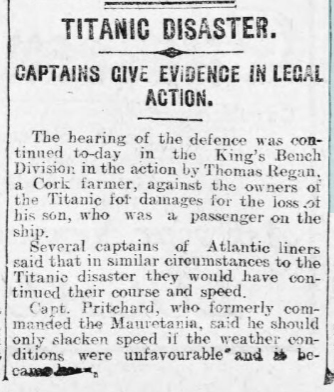
A year later North Atlantic captains of considerable
experience were still defending Smith's actions.
(The Cambria Daily Leader, 24 June 1913)
The British Inquiry was not the only occasion that North Atlantic captains came to the late Captain Smith's defence. More than a year later, according to the June 24th, 1913 edition of The Cambria Daily Leader they appeared in court again, this time in a case brought by Thomas Regan, a Cork farmer, against the White Star Line, for the loss of his son. "Several captains of Atlantic liners said that in similar circumstances to the Titanic disaster they would have continued their course and speed. Capt. Pritchard, who formerly commanded the Mauritania, said he should only slacken speed it the weather conditions were unfavourable" (The Cambria Daily Leader, 24 June 1913)
As an example of high speed in less than favourable conditions, take Captain Arthur Rostron of the Carpathia - he raced to into the danger region, putting everyone on his vessel at high risk, narrowly missing collisons with icebergs. As Captain David G Brown noted "Rostron went full speed directly into the field of ice and icebergs with full knowledge that hitting one of those bergs had just sunk a larger, better compartmented vessel than the one he commanded. Nothing gave Rostron the right to risk the lives of his passengers and crew that night. In fact, his primary responsibility was to protect those people from harm by prudent navigation of his vessel. The lives of the people of Titanic were Captain Smith’s responsibility, not Rostron’s." (Encyclopedia Titanica)
The fact that Rostron ended up saving the 712 of Titanic's passengers means most overlook the risks he took - but they were the same risks that Captain Smith made and were simply the norm for the time. It took the Titanic disaster to change the mindset and to introduce safer sea practices and regulations.
As an interesting footnote, Richard Elliot, in his article "Could Titanic have survived a head-on impact?", points out that even with a reduction in speed the iceberg avoidance manoeuvre could still have maintained the same track and hence a same or similar grazing or side-on impact with the iceberg, resulting in the same or similar damage. (https://www.encyclopedia-titanica.org/could-titanic-have-survived-a-head-on-impact.html)
Back to Top menu14. Captain Smith did not "turn the corner" late
Captain Smith did not take Titanic 10 miles southwest of the Corner point before turning for New York as Officers Pitman and Boxhall later said. According to author Samuel Halpern, that story came about as a result of an erroneous SOS position.
See: http://titanicology.com/Titanica/PitmansCorner.html
Back to Top menu15. "Missing" binoculars would not have changed the situation
An often repeated claim is that if the lookouts had been supplied with binoculars they would have seen the iceberg sooner and disaster could have been reverted. This is not correct, for some basic reasons.
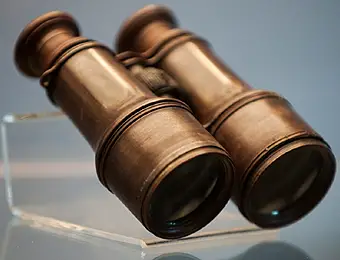
Binoculars recovered from the Titanic wreck. Some
sources, such as the Shutterstock library, claim they
were recovered from the Crows Nest..
Firstly, the binoculars were not "missing" as is often claimed. Actually there was at least one pair of binoculars on the bridge. During the British Inquiry, Lightoller noted that they had binoculars on the bridge "a pair for each senior officer...and the Commander, and one pair for the bridge, commonly termed pilot glasses." Lookout Frederick Fleet even admitted this during the US Inquiry when acknowledged that he was an 'officer on the bridge had glasses and was using them.' Interestingly, a pair of crew issue binoculars were recovered by RMSTI/IFREMER on the 1994 wreck expedition - confirming that binoculars were indeed onboard.
Secondly, binoculars (or "glasses" as they were often called) were not used to spot objects, but to identify them once spotted with the human eye. The reason for this is perfectly simple and is due to the fact that binoculars dramatically reduce your field of vision from 180 degrees to just a few degrees, resulting in the loss of peripheral and situational awareness if kept constantly to the eye. Essentially, they create a "tunnel vision" effect that reduces field of view. Lookouts instead would scan the area with their naked eyes and then, if available, use binoculars to identify an object once spotted. Additionally, binoculars of 1912 were not effective at night for detecting objects.
Lookout Frederick Fleet once again admitted to this procedure during the US Inquiry saying that he would not have his eyes to the glasses most of the time explaining "if we fancied we saw anything on the horizon, then we would have the glasses to make sure." At the British Inquiry Fleet was also pushed on this matter and eventually stated:
Sir Robert Finlay: Do you agree with this. This is what Symons says: “You use your own eyes as regards the picking up anything, but you want the glasses then to make certain of that object.” Do you agree with that?
Fleet - Yes.
The other lookouts also agreed:
Do you mean you believe in your own eyesight better than you do in the glasses?
Yes.
– Lookout George Hogg (B17518)
As a rule, do I understand you prefer to trust your naked eye to begin with?
Well, yes, you trust your naked eye.
– Lookout George Symons (B11994)
This was not just Fleet and Hogg's opinion, but confirmed in other testimony during the inquiries:
Do you think it is desirable to have them?
No, I do not.
– Captain Richard Jones, Master, S.S. Canada (B23712)
We have never had them.
– Captain Frederick Passow, Master, S.S. St. Paul (B21877)
I would never think of giving a man in the lookout a pair of glasses.
– Captain Stanley Lord, Master, S.S. Californian (U. S. Day 8)
I have never believed in them.
– Captain Benjamin Steele, Marine Superintendent at Southampton for the White Star Line (B21975)
“Did not believe in any look-out man having any glasses at all.”
– Sir Ernest Shackleton, Antarctic explorer
1846. They are a source of danger, Sir. They spoil the look-out.
21847. How is that?
The look-out man when he sees a light if he has glasses is more liable to look at it and see what kind of a ship it is. That is the officer’s business. The look-out man’s business is to look out for other lights.
– Captain Bertram Hayes, Master of the White Star Line’s Adriatic
In summary Second Officer Lightoller when he was asked if binoculars would not have helped the lookouts identify what they saw as an iceberg sooner, replied: “He might be able to identify it, but we do not wish him to identify it. All we want him to do is to strike the bells.” (British Inquiry, B14293)
More information in this article here: We have no look-out glasses in the crow's nest.
Back to Top menu16. Titanic's "shut up" wireless message was not rude
A popular scene in Titanic films is when the Californian's only wireless operator, Cyril Evans, is told to "shut up" by Titanic's chief wireless operator Jack Phillips. Narratively, it sets off an intriguing set of events in which the Californian's wireless is turned off - hence missing Titanic's later distress calls.
However the "shut up" message is often misconstrued as Phillips rudely insulting Evans, when actually that is not entirely accurate. It is correct that such a message was sent. At 11:07 on Sunday 14th of April 1912 Evans sent the following message to the Titanic:
Evans (Californian): “MGY this is MWL. We are stopped and surrounded by ice.”
Phillips (Titanic): "Shut up! Shut up!! I'm working Cape Race! Keep out!"
Indeed Phillips was busy "working" Cape Race. The wireless had broken down and a backlog of messages had accumulated. However the term often focused on - "shut up" is not as it seems. Phillips had used the code "DDD" which is translated "shut-up" but not with the same aggressive meaning that it has in normal conversational English. It was procedural code between operators meaning to 'give way' to ensure efficiency and was not meant to be interpreted as an offensive insult. Especially since all messages could be heard by any radio it is unlikely that Phillips would broadcast a message intended to be rude.
It must also be noted that on top of the backlog of messages, the Californian's message would have come across in Phillip's headphones as much louder than the faint transmissions from Cape Race, so may well have given him a jump. Evans was in effect interrupting Phillip's work. Author Tim Maltin explains: "When Evans interrupted Phillips, the loud spark from the Californian, lying only about 10 miles to the northward of Titanic, blasted in Phillips’ ears as he was listening to the much quieter signals from Cape Race, 400 miles away. This painful interruption would have obliterated the communication Phillips was sending, meaning he would have to begin his current sentence again. Phillips instinctively told Californian to ‘Shut up’ or ‘Keep out’, and explained: ‘I am working Cape Race.’ This was not unusual in the Marconi banter of the day, and would not have been taken as a great insult, but in his haste and pique, Phillips did not ask for Evans’s position and did not inform the bridge of this communication." (Check here for more information: https://timmaltin.com/2019/03/05/titanic-radio-operator/)
Author Samuel Halpern also notes about Evan's message: "The problem is that the message from Evans should have been prefixed with an MSG and it should have contained a position report. Otherwise, it was simply one operator chatting with another which had the lowest priority."
Michael Brady in his YouTube video also points out that the wireless operators were the "new breed of tech geek" and "chatted informally with abbreviations" such as OM ("old man") and GTH ("go to hell"). Some of the expressions could be seen as "shocking language" but they were a small group and most knew each other. Brady references Sir James Bisset's book "Tramps and Ladies" who recollects similar occasions and banter used over the wireless. Brady concludes that "Marconi men were used to talking to each other in a vulgar way… The past is a foreign country; they do things differently there… the real reason Jack Phillips was rude? He wasn't."
Check Brady's video here: https://youtu.be/CvLWcP_bD4w
As a further example of how the expression "shut up" was common code between operators, when the SS Birma, a British-built transatlantic passenger ship, responded to Titanic's distress call and eventually arrived on the scene at 7.30am, she picked up messages from RMS Carpathia reporting that they had rescued Titanic survivors, and the Birma offered supplies. The response from Carpathia was "shut up". This was attributed by Cannon to be part of a Marconi's Wireless Telegraph Company policy not to provide information to ships that did not use Marconi wireless sets. (More information here: https://www.encyclopedia-titanica.org/birma-bears-witness.html
Back to Top menu17. Titanic was not sailing at maximum (or "full") speed prior to collision
Although Titanic's engine telegraph orders were set to "Full ahead" from the beginning of her voyyage, she was not specifically sailing at her maximum "full" speed. This was because not all of her boilers were in use. As she made good progress across the North Atlantic, boilers were brought online gradually, as revealed in Leading fireman Fred Barratt's evidence during the British Inquiry that the "first two days when she left Southampton there were nine boilers out. The next two days there were eight out. ... They were not lit."
By 7pm on the night of Sunday April 14th, all 24 main boilers were lit, however there were still single-ended 'auxiliary' boilers in Boiler Room No.1 that remained unlit, according to the evidence of fireman Alfred Shiers, as well as J.Bruce Ismay, Barrett and Trimmer Dillon. This meant that Titanic was not sailing at her maximum potential speed prior to the collision - there was some untapped reserve capacity. Titanic's top speed was 23 knots. Just prior to collision Titanic was sailing at 21 and a half knots.
Back to Top menuD. Disaster
1. A mirage is possible, but not the key cause of the disaster
It is true that at the time of the collision there were unusual weather conditions that contributed to the disaster -notably a 'flat calm' that resulted in no swell, that made the icebergs difficult to see as there was no ocean breaking at their base, and additionally no moon, meaning there was no ambient light that would help illuminate the ice. It is a combination of these factors, plus the possibility of a "blue berg" (one that had rolled over) that are likely the primary causes for the iceberg being obscured from view until it was too late.
During the inquiries lookouts Lee and Fleet did mention a haze on the horizon. Reginald Lee at the British Inquiry noted that it was "a clear, starry night overhead, but at the time of the accident there was a haze right ahead... in fact it was extending more or less round the horizon. There was no moon." Frederick Fleet also mentioned "a sort of slight haze...it was only about 2 points on each side." While Lee and Fleet connect the haze to the time of the sighting of the iceberg, George Symons, who was on shift until 10pm described it as "a little hazy on the horizon, but nothing to speak of." Fleet also played down the importance of the haze, adding that "it was nothing to talk about...It did not affect us, the haze...we could see just as well." During the Ryan v. OSNC Titanic trial in 1913, Lee went further stating that "a portion of the berg was above the haze. When [I] saw the berg [I] did not think [I] could see the lower part of it below the haze. If the whole berg had been covered with haze [I] would not have seen it so soon."
Generally speaking, talk of haze has been dismissed. First, if such existed, the bridge should have been immediately notified, and there is no evidence it ever was. Secondly, Captain Smith and Second Officer Lightoller would have commented on it during their 9pm conversation, and Lightoller never referenced it. Thirdly, it was only mentioned in the British Inquiry, not earlier, indicating possible collusion between the lookouts when it appeared they would be blamed for not sighting the iceberg earlier. Fourthly, the lookouts description of the haze varies in both timeframes and location, making it unreliable. It is quite possible they were simply refering to the sky and horizon not having a defined dividing line i.e. they could not tell where the sky ended and the sea began. Lord Mersey, the British Wreck Commissioner presiding over the 1912 British Inquiry decided: "The evidence before and after the accident is that the sky was perfectly clear, and therefore if the evidence of the haze is to be accepted, it must have been some extraordinary natural phenomenon."
Modern day researchers, such as author Tim Maltin in his 2012 book "A Very Deceiving Night", have said that the possible haze was actually an indication that a "cold water mirage" (also referd to as a "refraction haze," "abnormal refraction,"" "thermal inversion" or "superior mirage") may have been at work.
However, there are those who argue the possibility of a mirage obscuring the iceberg via a false horizon does not apply for the following reasons:
A ) There is no eye-witness evidence of a mirage or refraction effects. As already mentioned above, the three lookouts Fleet, Lee and Symons only referenced a "haze." - although their evidence is inconsistent and likely unreliable.
B) The highest part of the iceberg would be at or below the horizon and would be seen against the black background of the sea. Titanic author and researcher Sam Halpern calculated that "The height of the berg was about 70-75 ft above the water, about 20 ft below the level of the crow's nest." Even if there was a mirage, it would not affect the situation, as the height of the eyes of the lookouts in the crows nest would mean that the iceberg would be below the line of the horizon. Even if it was above the horizon when viewed lower, any false horizon would be behind the iceberg, therefore it could not hide or obscure the object in front of it.
C ) It was night-time - 11.40pm. It is notable that all examples of mirages creating false horizons are in the daytime - as it involves refracted light. However, at the time of the collision the sun had set three hours earlier and there simply was no light reflected off the sea that could be bent to create a false horizon. The sea was ink black.
D ) The effect of a mirage - often claimed to be on the horizon and/or behind the iceberg - would be to make objects more apparent, often magnifying the size, inverting or elevating its height. Neither of these effects were reported and if so, would surely have made the iceberg easier to observe and not concealed it.
E ) Scientific research written by meteorologists in the paper "Reconstructing the prevailing meteorological and optical environment during the time of the Titanic disaster" (dated (7 October 2014) came to the following conclusion: "With high fidelity, our simulation captured the occurrence of an unusually high Arctic pressure system over the disaster site with calm wind. It also reproduced the movement of a polar cold front through the region bringing a rapid drop in air temperature. The simulated results also suggest that unusual meteorological conditions persisted several hours prior to the Titanic disaster which contributed to super-refraction and intermittent optical turbulence. However, according to the simulations, such anomalous conditions were not present at the time of the collision of Titanic with an iceberg." (Citation: Sukanta Basu, Christopher G. Nunalee, Ping He, Steven T. Fiorino, Mikhail A. Vorontsov, "Reconstructing the prevailing meteorological and optical environment during the time of the Titanic disaster," Proc. SPIE 9224, Laser Communication and Propagation through the Atmosphere and Oceans III, 92240Y (7 October 2014); https://doi.org/10.1117/12.2063195)
Nonetheless, it is quite possible that the conditions did contribute to a case of 'mistaken' identity between the Titanic and Calfornian, as investigated in this Smithsonian article:
https://www.smithsonianmag.com/science-nature/did-the-titanic-sink-because-of-an-optical-illusion-102040309/
2. Solar storm would have little impact on the disaster
It is a little known fact that at the time of the Titanic disaster an Aurora Borealis ("Northern lights") was indeed observed by eyewitnesses. But recently, this natural phenomena has been brought to the forefront by those who claim that it disrupted and/or scrambled wireless transmissions, skewed Titanic's compasses resulting in an incorrect SOS position, and interfered with the Carpathia's compasses resulting in her finding the sinking scene despite an erroneous SOS position.
However, Titanic explorer and researcher Parks Stephenson has noted that it likely had little to no impact on disaster. He firstly points out that while there was a solar storm it was not of any magnitude to have caused what is being claimed, being a "mild geomagnetic storm", but that also Titanic was operating on a radio frequency not known for interference unless it is a very large magnitude solar event:
"Titanic and the other ships that night in 1912 communicated with one another on the 600-meter wavelength, which equates to what we would now call the 500 kHz frequency, in the Middle Frequency (MF) range. It takes a very powerful event to disrupt frequencies that low. It was this precise quality that enabled the 500 kHz frequency to remain in use as an International Distress frequency with 24-hour watch until the 1990s, even as normal communications migrated to much higher frequencies. The Canadian Armed Forces still uses 500 kHz as an operating frequency for operations in the polar regions, where geomagnetic activity is routine. They have suffered only one atmosphere-related outage of 500 kHz in over a century of usage. Not only is the MF of 500 kHz very robust during periods of atmospheric interference, but we also have no historical evidence that Phillips encountered any problem in clearing out his message backlog with Cape Race the night and day before the disaster."
Stephenson also notes that even if Titanic's compasses had been affected, it would have had little effect on their course as it was not the primary means of calculating their position. "1) the iceberg’s position was neither fixed nor known, and 2) the year 1912 is not 2020…. the crew of Titanic, who had only recently transitioned from sail to steam, [used] navigation determined by mechanical clocks, nautical almanacs, celestial sightings and DR (dead reckoning, which is essentially an educated guess on where you are, based on what you know about where you were). . The last time the crew of Titanic knew where they were on the ocean’s surface was at around 1930 the night of the 14th, when Lightoller and Pitman took a set of star sights. Those values were handed over to Boxhall to calculate the ship’s position (a celestial fix based on the 1930 star sightings, but physically marked on the captain’s chart at around 2200). After he received the star sightings, Boxhall took additional star bearings to check for compass error; in essence, he performed a sanity check to see if the heavens and magnetic deviation matched…if you followed the process that I described above, you will notice that I didn’t mention anything about compasses, except where I described Boxhall conducting additional star sightings in order to check the local compass deviation against the stars in the sky."
Finally, as for the Carpathia's position, actually it was ultimately guided by the sighting of a green flare, from Fourth Officer Boxhall, about 20 miles away, not by a compass position.
Back to Top menu3. Head on collision would not necessarily have been better - also an unthinkable option
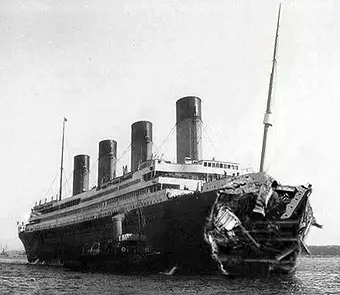
A popular Photoshopped image of what the Titanic
may have looked like after a head-on collision.
A frustrating comment frequently made is that if Titanic had hit the iceberg head - on it would likely have survived. But there are at least 5 key issues with this "theory."
A) First, it would be unthinkable for a RNR (Royal Navy Reserve) officer with the experience that First Officer William Murdoch had to give such an insane order. It would be a catastrophic career ending decision. There is no professional or official guidance that would instruct him to do so and he would have been hauled before the courts with multiple negligence claims if he had done so. In fact, Murdoch's order still align with modern seafaring expertise. For example, in the book "A Guide to the Collision Avoidance Rules: International Regulations for Preventing Collisions at Sea" (A. N. Cockcroft and J. N. F, Lameijer, First Edition 1965, Seventh Edition 2012), the authors wrote: "When collision ... is considered to be inevitable, the foremost concern of the officer must be to manoeuvre his ship so as to reduce the effect of the collision as much as possible. ... The engines should be stopped, and the helm should be used so as to achieve a glancing blow rather than a direct impact. The damage would probably be the least serious if the impact is taken forward of the collision bulkhead." Additionally, we do not have Murdoch's account of what happened and the reasoning behind his orders. We simply do not know what he saw, exactly what he did, what he was trying to do and what he judged was achievable.
B) Second - Titanic was travelling at almost its top speed and its impact with a solid wall of ice would not only have caused considerable damage but would have killed a large number of people in the bow section and injured many more throughout the ship. Remember that hitting the iceberg would mean a 50,000 ton ship going from 21 and a half knots (27mph) to coming to a dead stop within a few feet - the momentum of such an impact would be enormous. The forward section, comprising of more than 250 crew and steerage passengers, would be destroyed with a large loss of life. Everyone standing would fall. Those in their beds would be thrown to the floor. Damage would not necessarily be localised to the bow; damage can occur in other locations of the hull. Pressure from the sudden impact would have to be released somewhere along the hull no doubt compromising structural integrity.
Titanic researcher Terri Bey makes an interesting point on this: "The Titanic was a passenger liner and her bow was built to collapse. An icebreaking vessel has a bow that is purposely made to break ice. Had Titanic hit the berg head-on, there would have been dozens, if not hundreds dead because there were passengers and crew who had their cabins in the bow area."
C) Third - we don't know the shape of the iceberg - it could have caused more damage. It is a well-known fact that an iceberg is only about 10% above water. With this in mind we do not know exactly what lay beneath that fatal iceberg. First Officer Murdoch came very close to pulling off a very complex manuever in which he "port around" the berg - so a head-on trajectory could have caused even more extensive damage to the ship than simply destroying the forward section, especially if the irregular shape of the iceberg penetrated other areas of the ship leading to multiple water-tight compartment failure, resulting in a sinking that would be too fast to accomplish any efficient evacuation.
D) Fourth - the damage could have been fatal. Even excluding the unknown shape of the iceberg, if we take just a forward collision with the iceberg the damage from that itself could have been fatal. Titanic's mass and momentum would result in her bow superstructure being crushed possibly up as far as the bridge area, warping bulkheads and ultimately causing watertight doors to jam (as happened on her sister ship the Britannic) which would lead to more rapid flooding overall a faster sinking or even capasizing of the ship.
Some also believe that a head-on collision would have created huge stress on Titanic's expansion joint, resulting in a serious breach of the hull causing the ship to sink within minutes, not hours. Other researchers such as Andrew Noll have speculated that the iron rivets holding the ship together could have failed causing a "rippling effect down the hull [that] could of opened up seams all along the hull leading to more flooding along the length of the ship."
Titanic researcher John Nutzmann also commented on this:
Even under the best of conditions of running into a wall of ice at 22.5 knots, one has to take into account of the ship’s momentum of 58,587.2 tons and having it come to a dead stop within several feet, as much as the ship could penetrate the iceberg. The energy generated by the collision would have been as much as 3,560,495,839.65 joules (1 ton of TNT = 4,184,000,000 joules). Titanic would likely have foundered in minutes, not hours, and would have taken all hands, as distress signals and the launching of boats would likely not have been possible in the time frame the ship would have had left.
Another Titanic researcher Jean Scuissiatto notes about the watertight doors:
Yes, it might have only crushed the bow, but who would have gone to close all the watertight doors very quickly on that section? People have the wrong idea that all watertight doors were automatic, when only 12 of them were, these were the ones on the lowest level. All others had to be manually closed by cranks. With the whole bow opened to the sea, she would have started to fill VERY fast, and if water made it's way to BR 6 and 5, she would be doomed and far worse than the actual scenario. And in this case I'm not even considering the watertight doors getting jammed by the hull twisting during the collision, something that happened on Britannic and could have happened with Titanic.
We also have a case in point for reference - Titanic's young sister ship the Britannic struck a mine on the 21st of November 1916. The impact caused the vertical watertight doors to jam and she sank 55 minutes later.
E) Fifth - It is very easy in hindsight to say what should have been done,, retrospectively. But ultimately, speculating on such a highly unlikely "what if" scenario is a waste of time - especially since no sane officer would consciously give an illogical order. Such a decision could have also led to a "buttery fly effect" of failures which would lead to a worst case scenario sinking with an even larger loss of life.
Science teacher and second class passenger Lawrence Beesely wrote, soon after the sinking, that he did not think First Officer Murdoch was to blame for trying to avoid the iceberg. He wrote: "It is said, too, that when he did see the berg he should have headed for her; that the glancing blow cut her open in the most vulnerable place. But what a choice to have to make! How many men would have the courage to head for the berg when every instinct told them to turn the ship away - even supposing it was not the best thing to turn her away! I cannot see how he is to blame." (8 May 1912, The New York Times)
Back to Top menu4. The "grounding" theory is unlikely
Due to the fact that some descriptions of the collision do not indicate a large crash, some have theorised that rather than a side-swipe of the iceberg, the Titanic actually 'grounded' on a shelf of the iceberg. The grounding theory is also based on a report of water coming up over the stokehold plates from below in the forward part of Boiler Room Number 4
However, a grounding is unlikely for the following 4 reasons:
1. Descriptions of the collision do not necessitate a 'grounding'. While some reports are more dramatic than others, some passengers and crew slept through the entire experience. The reason for this is two-fold: Firstly, First Officer Murdoch did everything in his power to avert a collision and almost succeeded in doing so. The design of the hull and angle of approach and widening flare of the prow meant that only light contact with the berg occured. Secondly, it depended on the person's proximity to the collision, their personality (for example, a heavy sleeper) and their unqiue story telling techniques as to how the collision would be described, leading to a wide spectrum of reports.
2. Eye-witness testimony in the affected areas i.e. the boiler rooms, is consistant with a side-swipe collision, for example Fireman Frederick Barrett's observations of the hull opening between Boiler Room No. 5 into Boiler Room No. 6. Ice was reported to have fallen in through some open portholes and water was seen on the windows of the Café Parisian just after the berg had passed by.
3. Water coming up over the stokehold plates from below in the forward part of Boiler Room Number 4 can be explained without a grounding being the sole cause. For example, Titanic author Sam Halpern has an indepth article that provides possible explanations that do not necessitate a grounding.
4. Evidence from the wreck does not support a grounding. A 1996 sidescan sonar survey agrees closely with the locations of reported damage seen in the minutes after impact. This damage is clearly side, not grounding damage.
5. There was no steering error
In September 2010, novelist Lady Louise Patten, Second Officer Lightoller's granddaughter, wrote a fictional novel entitled "Good as Gold" in which she claimed that confusion over rudder orders had caused 'an officer to steer into an iceberg instead of away.' Although in the media releases at the time she claimed it was based on truth, part of a 'family secret' there is actually no evidence to support her claim and ample evidence to prove it did not happen.
Lightoller was off duty at the time of the collision so did not witness the orders given. Patten herself was aged ten at the time the story would have been told, passed on to her by her grandmother 40 years after the event - a second hand tale that likely got confused in the telling as First Officer Murdoch's order of "hard-a-starboard" actually in effect is "hard-to-port" under the tiller commands at use at the time. There was also Sixth Officer James Moody standing behind Quartermaster Hichens who was at the wheel, to check the order was carried out correctly.
For more information as to why there was no steering error, please refer to this article here: https://www.williammurdoch.net/articles_18_Patten_steering_error.html
Back to Top menu6. There was no full astern order
Most cinematic portrayals of the collision sequence and until recently, many books, depict First Officer Murdoch ordering a "full speed astern" order in addition to "hard-a-starboard" leading to criticism of Murdoch as the reduction in speed resulted in less turning power. However, there is only one witness to this order - and he was not there when it was given: Fourth Officer Boxhall. Although he did not hear it called out as he approached the bridge, he puts the words in Murdoch's mouth during the conversation with Captain Smith, saying that he ran "the engines full astern" (US Inquiry) "reversed the engines" (British Inquiry) and "Full Speed Astern, Sir, on the Port Engine" (BBC interview October 1962).
However Boxhall is the only one person to mention the full astern order. Quartermaster Robert Hichens was at the wheel and only heard the order "hard-a-starboard" when he testified at both inquiries. Quartermaster Alfred Olliver (only questioned at the US Inquiry) only heard "hard a port" as he arrived on the bridge. Frederick Barrett, Leading stoker working in boiler room 6 only reported 'the red-light signal to stop' (US Inquiry). Trimmer Thomas Dillon in the engine room reported the engines were "stopped" after the collision and then "half a minute" later "they went slow astern." (British Inquiry). Greaser Frederick Scott testified that at "about 20 minutes to 12... four telegraphs rang... two emergency ones... I noticed "Stop" first"... on the main engines."" (British Inquiry). First class passenger C.E. Henry Stengel, who as a travelling businessman was no stranger to transatlantic travel reported: "I head a slight crash. I paid no attention to it until I heard the engines stop."
Reasons that most likely Boxhall's "full speed astern" did not happen:
1. No first-hand eyewitness testimony to the order being given (from those in the bridge/engine room/boiler rooms)
2. No eye-witness testimony to the effects of full astern (there would be noticeable movement) e.g. Lightoller does not believe the ship was ever ordered "full astern" notably saying that "I cannot say I remember feeling the engines going full speed astern." (British Inquiry)
3. The only 'witness' to this order - Fourth officer Boxhall - was not on the bridge at the time the order would have been given and also does not report hearing it, only "hard-a-starboard". He only mentions "full astern" when he puts the words in Murdoch's mouth during the conversation with Captain Smith. And later in 1962 changes this to "full speed astern on the port engine." so it is unreliable.
4. Mechanically, there was not enough time for the engines to be able to reverse in time.
5. Reversing the engines would reduce Titanic's ability to turn (Murdoch was very experienced and would know that).
One important factor to note is that Boxhall was not in the bridge area at the time the orders were given so any information he provides is second-hand. As Hichens reported "from what I am given to understand, Mr. Boxhall was approaching the bridge" (British Inquiry). And Boxhall himself said "I was almost on the bridge when she struck." (British Inquiry).
At the British Inquiry he was directly asked: "And you knew the engines were reversed, full speed astern?" But instead of answering yes, he does not directly answer the question but replies: "I heard the bells ring, but I did not know what the movement was until I got to the bridge." (British Inquiry)
It was when he arrived on the bridge that he saw the telegraphs showing "full speed astern" (British Inquiry). However, it seems more likely that what he saw were the engine telegraphs set to "slow astern" as reported by Trimmer Tom Dillon in the engine room. Murdoch and /or Captain Smith was likely reducing Titanic's speed to then investigate the damage.
According to author Samuel Halpern, the actions of William Murdoch at the time the iceberg was first spotted were more deliberate than they were instinctive. He nearly pulled off a miracle. His overall conclusion is that Murdoch's response " was a masterful achievement in ship handling that met up with some bad luck." (More information see here: http://www.titanicology.com/Titanica/NarrowShave.pdf)
Back to Top menu7. The Captain and his officers were not drunk
Rumours started shortly after the sinking of the captain and his officers being drunk - both Captain Smith and Fifth officer Lowe were accused of drinking. Lowe was actually an "abstainer" stating under oath that "I never touched it in my life" and hence was highly offended by allegations of drinking and requested an official retraction.
24 year old second class passenger Emily Richards claimed Captain Smith was drinking in the saloon bar before the collision - but this is in contradiction to other eyewitness accounts. Captain Smith indeed dined with passengers on the night of the disaster. However, Saloon Steward Thomas Whitely said that while Captain Smith 'talked and joked with Mr Astor' but he 'did not see the captain drink anything; I do not think he even indulged.' (On a Sea of Glass, book). First Class passenger Harry Anderson said that Smith 'refused to drink that... night. When I insisted, he had a small glass of port, sipped once and left it.' In her brief affidavit to the Senate Committee investigating the disaster, Eleanor Widener herself wrote, “Capt. Smith drank absolutely no wine or intoxicating liquor of any kind whatever at the dinner.” Charles Stengel was insistent that captain smoked some cigarettes that night but definitely did not drink.
According to author Sally Nilsson (the great-granddaughter of Quartermaster Robert Hichens who was at the wheel of Titanic at the time of collision) First Officer Murdoch is guilty of a gross dereliction of duty as she firmly believes if he was not "out cold from the wine he had consumed at a celebration for his captain...lying on the lounge at the rear of the pilot house" the Titanic could have avoided the iceberg. Her claim is based on the evidence of a 'Luis Klein', a Hungarian man who alleged he was a surviving member of the crew with some sensational evidence involving officers and crew asleep "drunk or drinking". This resulted in the New York Times running stories such as "Officer on Watch Accused" on April the 22nd, 1912. However shortly thereafter Klein escaped before giving evidence and his reports were widely discredited. He is not to be found on any crew lists, Second Officer Lightoller testified he did not know him and the evidence Klein did provide does not fit with known evidence. Hence Klein has been widely accepted to be an imposter.
More information on false allegations of drinking can be found in the article here: https://titanicofficers.com/article_07.html
Back to Top menu8. Captain Smith was not in a daze
It is popular to portray Captain Smith as in a "daze" after the collision, almost catatonic. This was firstly based on reports such as Lightoller who described getting a nod as a reply from the Captain when he asked if he should load the boats. But the reason he only nodded was due to the volume of noise of the steam that was being vented due to the stopped engines. Also, Major Peuchen criticsed Smith's decisions and said "the captain was not quite himself." This was cemented into legend by the Hollywood portrayals of Smith in a state of silent shock.
However the facts are that he was very active throughout the evacuation, firstly making a thorough sounding of the ship, ordering radio distress calls in person and organising the safe evacuation of the ship. He was frequently seen both assisting in the launching of boats and directing lifeboats with a megaphone. Smith prudently chose not issue an "abandon ship" order until the last minute.
You can see a list of his actions and approximate timings here: https://titanicofficers.com/titanic_01_smith_11.html
Back to Top menu9. Titanic was not the first ship to use the "SOS" distress call
Another popular legend is that Titanic was the first to use the "SOS" distress call. While the call was relatively new, it had been used as early as 1909. For example, on 11 August 1909, the steamship Arapahoe, on a route between New York and Jacksonville, Florida, broke a shaft and began drifting off the North Carolina coast and used the "SOS" call.
For more information: https://www.snopes.com/fact-check/titanic-first-sos/
Back to Top menu10. J Bruce Ismay was not a "brute" or "coward"
Cinematic portrayals often show the president of the White Star Line, J.Bruce Ismay, as someone who interfered with the running of the ship (i.e. instructing Captain Smith to go faster) and eventually escaping aboard a lifeboat, taking the place of women and children. Ismay was indeed villainised by the press in the wake of the disaster - some even dubbed him J. “Brute” Ismay. The horrified public demanded a specific scapegoat for the disaster, and Ismay became that person. His exaggerated character also became a convenient and poignant storytelling device.
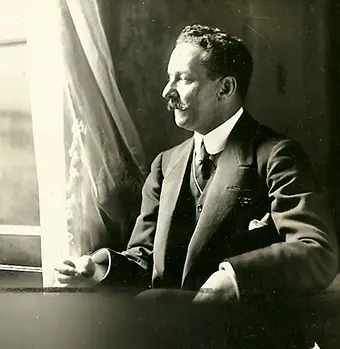
J.Bruce Ismay photographed at the United States
Inquiry. He was neither a "brute nor "coward".
However as brought out during the United States and British inquiries, there is no evidence that he unduly influenced Captain Smith over the matter of speed. Indeed, neither inquiry found him guilty of anything at all. But there is evidence that he helped extensively during the starboard evacuation, assisting with the loading and lowering of the lifeboats (although upsetting Fifth officer Lowe in the process, as he did not know who he was).
He did enter the last lifeboat to be lowered on the starboard side - something for which he received heavy criticism. Some claim that in doing so he saved himself at the cost of the lives of women and children - but that is not correct, for 2 key reasons:
1. He was following orders. Chief Officer Wilde and First Officer Murdoch were in charge of lowering collapsible C and reports indicate that they ordered Ismay in to the lifeboat - as they had done for several men on the starboard side where the "women and children" order was less strict, interpreted as "women and children FIRST" not "women and children ONLY." Both Wilde and Murdoch were armed with revolvers at this point, for crowd control, and Ismay entering the lifeboat must have been either instigated or at the very least cleared by them. Ismay was aboard Titanic in the role of a passenger, not a crew member, so obeyed the officers orders, as well as setting an example for other passengers, as many had been reluctant to enter. He was no different from any of the other dozens of men saved on the starboard side, for example, Cosmo Duff-Gordon, Sloper, Karl Behr, Stengel, Lawrence Beesley... all of whom were also ordered into lifeboats on Murdoch's orders.
2. He was not taking anyone's place
The most common criticism is that he was taking the place of women and children - but that is not true - there were spare seats aboard collapsible C, it was not fully loaded when he entered. If Ismay had not taken that seat, it would have remained empty and he would be an extra number to add to the causality lists and one less survivor.
In the wake of a disaster, so many people want to find a scapegoat and hence "criminalise" certain people such as Smith or Ismay. However, the real cause of the Titanic disaster is far more subtle and also considerably more dangerous: complacency.
Back to Top menu11. Third class passengers were separated by gates but not systematically locked behind the gates during the sinking
While there were indeed gates which separated first, second and third class, this was actually a legal requirement set by US immigration authorities to avoid the spread of infectious diseases, rather than a White Star Line concept. Author George Behe has recently discovered that Olympic and Britannic both had Bostwick gates that were not shown on the commonly-available deck plans, and it's quite possible that Titanic had such unmarked gates as well.
However there is no evidence these gates were intentionally and systematically all kept locked during the sinking as often portrayed in films.
According to Tim Maltin "In fact, first class stewards were sent straight down to the third class to tell people exactly where the boats were….The law was that no passenger ship could go to America without these gates shut. It was only in a state of emergency that the gates were allowed to be opened. On the Titanic, the gates were opened as soon as a state of emergency was declared, 47 minutes after the ship hit the iceberg." (Daily Mail article)
The high number of third class passengers who died was more likely due to the longer distance to the lifeboat stations and also language barriers. According to Tim Maltin it was also due to reluctance because they 'did not want to' get in life boats. He states that, in 1912, boys were classed as adults from the age of 13, meaning teenagers were only allowed into life boats after women and children had taken their places. Because poorer families were going to America in search of a new life, they did not want to lose teenage or male members of their family. 'So you could imagine these women and men with families going to America,' Mr Maltin said. 'What you don't want to do is leave behind your 13-year-old son, your 14-year old son, your 15-year-old daughter. So what they did is they decided they would be better off sticking together. If they were going to leave the breadwinner behind dead in the icy waters of the Atlantic, what hope would there be for the mother on her own?' (Daily Mail article)
Walter Lord examined the question of third class gates in his book “The Night Lives On” and concluded that primarily language barriers, and an unwillingness of families to be separated, contributed to the high death toll in third class.
The highly recommended book "On A Sea of Glass" has an appendix section Q entitled "Trapped 'Like Rats'" which analyses the location of the gates and eyewitness accounts and concludes that it "seems very unlikely that many of the ship's Steerage passengers were deliberately locked down within the ship's lower decks…there is no evidence of a systematic 'extermination' of Steerage passengers in the historical record… while the historical record clearly shows some unfortunate incidents, these were apparently few and far between." (On a Sea of Glass, book).
Back to Top menu12. Stoker Frank "Lucky" Tower did not survive the Titanic, Empress of Ireland and Lusitania sinkings
A story about a man surviving all three disasters sounds like a legend -and indeed it is an urban legend, as no such man with the name Frank "Lucky" (or "Lucks") Tower appears in the crew list on any of these tragic voyages. There was a survivor named Frank Tower from the Lusitania, and a William Clark who survived both the Titanic and Empress of Ireland sinkings.
More information:
https://en.wikipedia.org/wiki/Frank_Tower
https://www.encyclopedia-titanica.org/lucky-tower.html
13. Stewardess Violet Jessop did actually survive the Olympic, Titanic and Britannic.
In a remarkable story stewardess Violet Constance Jessop (2 October 1887 – 5 May 1971) survived the Olympic's collision with HMS Hawke (20 September 1911, the Titanic sinking (15 April 1912) and the Britannic sinking (21 November 1916) becoming known as the "Queen of sinking ships," and "Miss Unsinkable". Her memoirs have been published in abook entitled "Titanic Survivor".
Back to Top menu
14. Black woman did not die aboard Titanic
In an attempt to create a racist element to the sinking there is a claim that a black woman named Malinda Borden perished on the Titanic. However this is false. There was no such woman by that name aboard Titanic.
Kyle Hudak's website covers this claim here: https://magnificenttitanic.tumblr.com/post/183179096477/was-a-black-woman-named-malinda-borden-on-titanic?
Also Snopes has an article on this false claim: https://www.snopes.com/fact-check/malinda-borden-titanic-lifeboats/
Back to Top menu15. An officer possibly shot passengers and then himself
Titanic's senior officers - Smith, Wilde, Murdoch and Lightoller were all armed with White Star Line issued Webley .455 calibre “pistols”( No. 1 Mark VI). There is substantial eye witness evidence of an officer or officers using their guns during the lifeboat evacuation - including the shooting of passengers and an officer suicide. The identity of this officer is subject to much speculation and the mystery will likely never be solved.
You can check the eyewitness evidence for and against here: https://www.williammurdoch.net/mystery.html
Back to Top menu16. Distress rockets Titanic fired into the air were not the wrong colour
The distress signals (rockets) fired into the air as Titanic was sinking were white, which were regulation distress signals. The eyewitnesses who said that they were coloured was likely due to the adapted night vision and the colour seen in wreck photography is likely due to corrosive elements.
Hence, the officers fired the correct standard distress signals (rockets) and claims that they were coloured and thus misinterpreted are misleading.
For more information:
Signals of Distress – What Color Were They? (Revised: February 2021) by Samuel Halpern:
http://www.titanicology.com/Californian/WhatColorWereThey.pdf
17. Extra lifeboats would have saved more but certainly not everyone
A common myth is that if Titanic had enough lifeboats for everyone nobody would have died. This is an oversimplificiation and is essentially incorrect for several key reasons/factors:
* General reluctance on the part of many passengers to enter. Especially wives who were unwilling to leave without their husbands.
* Language barrier and confusion among foreign passengers as to the urgency of the situation.
* More lifeboats could have led to further complacency and less urgency.
* Lack of time to launch all lifeboats. Only 18 lifeboats out of a total of 20 were launched before Titanic sank. On the 25th of May 1912 when Senator Smith visited the Olympic and a lifeboat was lowered with a capacity of 65 it took a total of 18 minutes, as described in Wyn Craig Wade's book "Titanic: End of a Dream" p. 279/280.
* Lack of crew to launch the lifeboats.
* Lack of crew to man the lifeboats once launched.
Thus, when considering the points above, an increase in lifeboat capacity, while likely leading to an increase in the number of survivors, would almost definitely have not saved all aboard Titanic.
However, author Paul Lee believes that if people were mustered correctly, all could have potentially been saved: http://www.paullee.com/titanic/everybodysaved.php
Interestingly, Bob Read has written an article also suggesting that loading Titanic's lifeboats to capacity would actually be dangerous, as they were never tested to full capacity, concluding that "what may have prevented a greater disaster was the common sense and intuition of Titanic’s officers who did not fully load her lifeboats before launching... the Olympic davit test evidence at least casts doubt on the adequacy of Titanic’s davits" ("New Evidence of the Possible Danger of Loading Titanic’s Lifeboats to Capacity", By Bob Read, D.M.D. http://www.titanic-cad-plans.com/wp-content/uploads/2019/11/Davit-Failure-Article.pdf)
Back to Top menu18. Californian could not have saved everyone
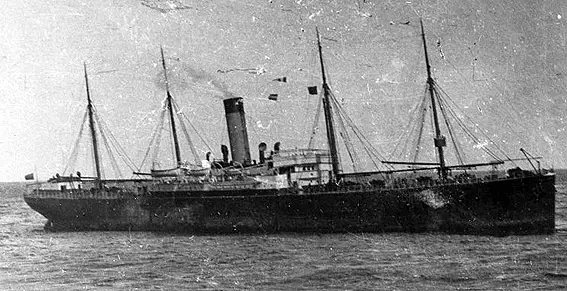
The SS Californian could not have saved everyone.
Another common misconception is that if the Californian - often referred to as the "mystery ship" that did not respond to Titanic's distress calls - had responded and come to the rescue they could have saved everyone. The reality is that if they had made it onto the scene in time they would have not been able to save many.
Firstly, what is often overlooked is the danger involved in navigating ice to reach the Titanic - which would not only have endangered the ship, but also greatly reduced the speed she could travel at and negated her response time and effectiveness.
According to extensive research on the subject entitled "The Californian Incident, A Reality Check" - "although it seems likely that at least a few additional Titanic passengers could have been pulled from the water alive if Californian had made it to the wreck site before 2:45am, Captain Stanley Lord and the Californian could not have saved the 1500 remaining passengers from the sloping decks of Titanic. No Captain could."
For more information: "The Californian Incident, A Reality Check, by by Tracy Smith, Michael H. Standart & Captain Erik D. Wood"
https://www.encyclopedia-titanica.org/californian-incident.html
19. The Mount Temple (or the Samson) was not the "mystery ship"
There has been a recent resurgence in this theory due to a 2020 documentary entitled "Abandoning the Titanic" which repeated claims that have already been debunked. In simple terms - it is impossible for the Mount Temple to have been the "mystery ship" for several key reasons, but most notably that it was geographically impossible. When the mystery lights were first spotted the Mount Temple was 46 miles west of Titanic and still steaming at full speed towards Boston. The Mount Temple in fact did not turn round to go to Titanic's rescue until about 12.30, 25 minutes after the stationary mystery ship was first spotted - and at such as distance that it was impossible to have been seen by the sinking ship. By the time the Titanic sank the Mount Temple was at least 26 miles west, with a 6 mile wide icefield between them.
Titanic author and researcher Dr Paul Lee analyses the claims, creating a CG simulation of the propose route and concludes that "since it can be proven quite ably, through simple navigation considerations… that the Mount Temple could not be the "mystery ship," does one really need to waste one's time considering the anecdotes of people who either repeated hearsay, weren't even on the ship, or wouldn't commit themselves to giving testimony or affidavits under oath?" Source: "The Titanic and The Mount Temple - A Tale of Two Ships" - by Dr Paul Lee http://www.paullee.com/titanic/mounttemple.php
In an excellent, peer researched analysis of the claims made in the "Abandoning the Titanic" documentary, authors and historians Mark Chirnside, Tad Fitch, Samuel Halpern, J.Kent Layton and Bill Wormstedt have written "Abandoning the Titanic, Abandoning Reality: The Truth About the SS Mount Temple" which step by step dismantles the various erroneous claims concluding that the "programme presented a highly biased, highly flawed, and very one-sided story.". For example it "totally ignored the overwhelming evidence that Titanic ended up facing northward… The Mount Temple was too far away for any‐one to have seen her from the Titanic… Mount Temple could not have been within visual distance of the wreck site until long after the Titanic sank….he show’s writers also chose to ignore any evidence that contradicted their many allegations."
To read the full analysis please check here: https://wormstedt.com/Titanic/Abandoning_the_titanic.pdf
Additionally, in later years there have been claims that the seal hunting ship the Samson was the mystery ship. However, Lloyd's and Icelandic records show that the Samson docked in Isafjordur on April 6 and 20, 1912, making it unlikely that it encountered the Titanic and makes her presence on the scene impossible. The Washington Post of June 29, 1991, elaborated: "British researcher and lifelong Titanic scholar, Leslie Reade, obtained microfilmed records from Iceland in 1973 that appear to show that the Samson arrived in Isafjordur on April 6 and again on April 20, 1912, which would have made it impossible for the ship to have been hundreds of miles away at the Titanic site on April 14."
More information:
The Washington Post, 29 June 1991, news article
20. The last song played by the band was not Autumn - most likely the British version of Nearer My God to Thee
The exact song played by Titanic's band will probably never been known, but it was most likely Nearer My God to Thee, based on the sheer volume of eyewitness accounts from across the spectrum.
Much has been made of junior wireless officer Harold Bride's claim that the last song played by Titanic's orchestra was "Autumn" calling into question the popular portrayal of the bandsmen playing "Near My God to Thee" just as Titanic sinks. However, the claim that Bride heard "Autumn" is dubious. Firstly, Bride was a notoriously unreliable witness. Further, in George Behe's book about Titanic's bandsmen entitled "Those Brave Fellows" he notes that that in 1912 ten survivors wrote in primary sources that "Nearer My God to Thee" was the final song played, and the only survivor who mentioned "Autumn" at all wrote that "Nearer My God to Thee" was played after "Autumn" concluded. Behe also notes that Bride's "Autumn" story appeared only in a newspaper interview, rather than a primary source . while in contrast to Bride's newspaper interview, at least sixty other newspaper interviews with different survivors mentioned that "Nearer My God to Thee" was the final song played. Behe believes that Bride never mentioned the tune "Autumn" at all in his first-hand accounts or inquiry testimony. Instead, it was the reporter who wrote Bride's first newspaper interview who claimed that Bride heard that tune. Author Dr Paul Lee is of the same opinion stating that Bride doesn't say that "Autumn" was the last tune played. He simply says that he heard it.
Accounts of "Nearer My God to Thee" started aboard the Carpathia, revealing that it was not necessarily tabloid fiction. And it is notable that the band leader Wallace Hartley is reported to have told Leeds musician Elwad Hatley that if a ship would ever sink he would indeed play "Nearer My God to Thee". Authors of the book "On a Sea of Glass" after examining the evidence conclude that the "sheer volume of claims that 'Nearer My God to Thee' was played highly suggests that there is at least a kernel of truth to the stories… there is a strong possibility that both 'Autumn'… and 'Nearer My God to Thee were indeed played that night…First Class passenger Helen Candee, in her account of the sinking raises the possibility that both of these songs were indeed played by the band during the sinking: "And over them trembled the last strains of the orchestra's message: 'Autumn' first, then 'Nearer my God, to Three.""
As there are several versions of "Nearer My God to Thee" there is also conjecture over which one was played. According to Titanic historian and author Don Lynch "it seems like most of the people who claimed to have heard Nearer My God to Thee were British, so it's unlikely the American version was played."
Back to Top menu21. The Titanic was openly reported by many eyewitnesses of splitting in two - there was no cover up
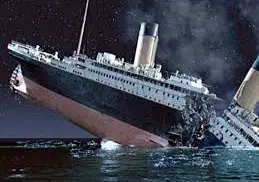
Titanic splitting in half as portrayed
in the 1997 film "Titanic".
One of the frequent criticisms of the four surviving Titanic officers is that none ever stated that the Titanic split in half - a reality that, of course, was only confirmed with the 1985 discovery. The inference being that they colluded together to cover up what really happened. However, the likelihood is that they were not in the right position or angle to observe the split and hence decided rumours of the ship being torn in two were an exaggeration meant to further damage White Star's reputation. For example, Lightoller was forward of the ship when it sank and in the water, so was in a poor position to observe it. Also, the split was probably a lot less dramatic than Hollywood would have us believe and in a lot less light than many realise. Notably, three of the four surviving officers did hear "explosions" which in hindsight were quite likely the noise of the ship splitting:
Second Officer Lightoller: "the massive boilers left their beds and went thundering down with a hollow rumbling roar." (Lightoller's autobiography, Titanic and Other Ships)
Third Officer Pitman: "Four reports... they sounded like the reports of a big gun in the distance... I assumed it was bulkheads going, myself." (Senate Inquiry)
Fifth Officer Lowe: "Heard explosions, yes; I should say about four." (Senate Inquiry)
There were actually multiple accounts of the ship splitting at the time and it was openly reported. However many of the accounts were dismissed at the time as being tabloid exaggerations (along with other negative/biased rumours such as the officers all being drunk). There was no cover up. It took the discovery of the wreck to clarify what really happened.
More information:
https://wormstedt.com/titanic/The_Facts.html
http://www.paullee.com/titanic/sinking.php
22. There was no heroic dog called Rigel
In what can only be described as an incredible and heartwarming story, "Rigel", First Officer Murdoch's large black Newfoundland dog that survived the sinking while his master did not, spends three hours in the freezing water searching for him to no avail. However, in seemingly typical Newfoundland-fashion, he ends up guiding the occupants of lifeboat no.4 to the safety of the Carpathia.
The only issue is that it is not true. First Officer Murdoch did not own a dog called "Rigel," "Jonas Briggs," who told the story, was never a crew member aboard the Carpathia and there is no other eyewitness account of "Rigel".
More information here:
https://www.williammurdoch.net/articles_09_Murdochs_herioc_dog_Rigel.html
23. No one could have survived on the iceberg
There are several theories of what the crew could have done after the collision to save the passengers, but one of the most popular is that the passengers could have been offloaded onto the iceberg to await rescue.
Despite how ridiculous this theory maybe at first, it is actually quite simply out of the question, for the following key reasons:
1. After the collision the Titanic kept moving and the iceberg disappeared aft and was never seen again by any crew or passenger. By the time the Titanic came to a stop, the iceberg would have been several miles aways, and not visible to the naked eye. The Titanic also had turned to port, so the angle to the iceberg would have changed. And additionally, sea currents would have moved the iceberg, likely further away. It would have been a highly complex and likely fruitless task to try and find it. Not that it could have provided refuge anyway.
2. It was an iceberg, not an ice floe. While a floe is low, flat and relatively shallow, icebergs are more like a mountain, and rarely scaleable, with sheer cliffs, and no place to stand. Photographs of the possible iceberg that caused the collision look like an unlikely place of refuge for anyone but a few hardy passengers. It certainly could not take the nearly 1500 who lost their lives that night. Icebergs also tend to flip or roll over.
3. Access - a key question is how the passengers would access the iceberg even if it was near the ship (which it wasn't). There would need to be some kind of gangplank or rope ladder system in place - neither of which would have been feasible at the distances required, or in the dark with no light sources. Indeed, it would likely be concluded that the easiest way would be to ferry the passengers using the lifeboats - which puts us back to square one as it would be no different to the number who ended up in the lifeboats anyway. And accessing the iceberg from the waterline aboard a lifeboat would have been all but impossible - most passengers would have preferred to remain in the wooden lifeboats that on a freezing cold iceberg.
4. The inhospitable nature of the iceberg must also be considered. Most passengers were not dressed for the freezing cold temperatures, without coats or appropriate shoes and hence finding refuge on a piece of freezing, slipperly ice would be unthinkable - most would end up slipping off into the water, or succuming to hyopthermia on the ice cold surfaces. A few hours after the Titanic sank a swell and wind came up which would make this an even worse option. It would be surprising anyone could survive under those conditions.
5. Reluctance - what is often ignored with this theory is that most passengers were reluctant to get into the lifeboats until the last few minutes when it was obvious the ship was going to sink. Many lifeboats departed half-filled for this reason. This reluctance would have meant that the iceberg refuge theory would also collapse on this alone - there would simply not be enough passengers willing to take this option until it was too late.
A "Bright Side" video on YouTube investigated the theory and came to the conclusion that not only was it not feasible but it "would have made the disaster worse." More information: https://youtu.be/C5CEIxESSrs
Back to Top menu24. The time difference when Titanic sank
There has been some confusion over the correct time difference between Titanic time and GMT - the following chart clarifies the exact difference in time, which for New York, Titanic's intended destination, was 2 hours and 2 minutes:
_small.jpg)
Courtesy of Steve Hall. (Click image to enlarge)
25. Colonel John Jacob Astor was not crushed by a falling funnel
The story that Colonel John Jacob Astor was crushed by a falling funnel has its origins in Archibald Gracie's "The Truth About the Titanic" (1912, p31) which contains the following statement: "From the fact that I never saw Colonel Astor on the Boat Deck later, and also because his body, when found, was crushed (according to the statement of one who saw it at Halifax, Mr. Harry K. White, of Boston, Mr. Edward A. Kent's brother-in-law, my schoolmate and friend from boyhood), I am of the opinion that he met his fate on the ship when the boilers tore through it, as described later." Although the quote does not mention a funnel, it seems others have picked up on the term "crushed" and assumed this was due to a falling funnel, for example author Daniel Butler in his 1998 book "Unsinkable: The Full Story of RMS Titanic,"(page 136).
However when Astor's body was recovered by the ship the Mackay Bennett, it was catalogued in great detail - the full details of which can be viewed online as part of the Nova Scotia Archives. There is no indication regarding his body being crushed or damaged. In fact, in an article entitled "The Two Deaths of John Jacob Astor" author George Behe uncovered previously unknown eyewitness accounts which all confirm his body was in tact and with no signs of soot: Gerald Ross ("face was swollen, one jaw was injured"), John Snow ("excellent state of preservation") and Captain Richard Roberts ("features... unharmed, the face being only slightly discolored by water"). Behe concludes: "Although the above three accounts differ slightly in certain particulars, all three of them seem to confirm the fact that Colonel Astor's body was not crushed, soot-blackened or disfigured in a manner suggesting that he had been killed by either a falling boiler or a falling funnel. Quite the opposite, in fact."
Titanic collector Michael Betty has among his memorabilia a copy of "Sunbeam" from August 1912, a mortuary trade journal. It contains an article that details Astor’s body condition and the procedures done to preserve it and confirm he was definitely not crushed.
For more information:
Nova Scotia Archives: https://archives.novascotia.ca/titanic/fatalities/archives/?ID=124&Page=201010499
George Behe article: https://wormstedt.com/GeorgeBehe/page12.htm
26. Closing portholes would not stop the ship from sinking
There are many accounts that reference open portholes, or that passengers opened them after the collision to see what had happened. Chief Baker Charles Joughlin testified that portholes on E deck were "very often" kept "open the whole of the passage." First class passenger Charles Stengel referenced in his testimony that "another passenger said that the ice came into his porthole. His porthole was open...He just wanted air." At the Limitation of Liability hearings, first class passenger Emily Ryerson was specifically asked about her observation of the portholes while her lifeboat was being lowered, and she said: "Yes, a great many were left open." The reason for this was also likely due to a fault in the Titanic's heating system on Sunday evening that resulted in some cabins becoming unusually hot. Others may have had them open for want of fresh air due to a strong smell of paint and varnish in their new cabins. We must also be careful not to use imagery of open portholes on the wreck as a reference: they could simply be the result of the bow's impact on the sea floor.
So it is quite likely many of Titanic's 1,116 portholes were indeed open during the sinking. The obvious assumption is that open portholes would have exacerbated the sinking scenario, allowing the flooding of cabins and decks and hence hastening the ship's demise. In reality the portholes were a much smaller aperture than for example the gangway doors - also thought to have been left open. It is worth noting that the Titanic, although experiencing a list during the sinking, did not capsize - a possibility if there were large openings along oneside of the hull. In this respect there is no comparison with her sister ship the Britannic, which took a severe list to starboard during her sinking. There was also little in the way of observed suction, although Fourth Officer Boxhall did describe some as he rowed around Titanic's hull: "I did find there was a little suction just as I was pulling around the ship. I was lowered on the port side, and pulled around to the starboard side shortly afterwards, and I found there was suction then; that the ship was settling down broadside." (US Inquiry)
Overall, the effect of open portholes is neglible and closing them may have saved only a few minutes, but nothing more. The huge effort of closing the open portholes would not have justified the outcome and would likely have resulted in more deaths, with crew and passengers remaining below decks when a prompt evacuation was more critical. The moment the Titanic struck an iceberg which breached six of her water tight compartments she was going to sink - whether portholes were left open or not.
Back to Top menu27. Being "drunk" did not ensure baker Joughlin's miraculous escape

Chief Baker Charles Joughlin
33-year-old Chief Baker Charles Joughlin was possibly the last person to leave the Titanic, describing how the rode the stern of the ship down as if it was an "elevator" and that his hair may have been "wetted, but no more." He is perhaps more famous as the 'drunken baker' due to his depictions as such in the two most popular Titanic films - "A Night to Remember" (1958) and "Titanic" (1997).
He testified at the British Inquiry that he was in the water for 2 hours, in a lifebelt, hanging onto the side of upturned collapsible B, before he was transferred into a lifeboat, and described it as feeling colder out of the water than in. However it is highly unlikely he survived partially submerged in -28F (-2C) water for that long. Many have suggested it was due to the effects of alcohol. While alcohol does indeed provide the feeling of warmth, it also dulls the senses and constricts blood vessels which is far more dangerous and offers no protection to hypothermia.
While he did testify that he returned at least twice to his cabin for liquor, what is often omitted is that he also testified to visiting the pantry for water - not alcohol - shortly before the ship sank, and never described himself as intoxicated or drunk. He was also not overweight (Titanic researcher Phil Gowan noted he was 5ft 4 inches and weighed 155 pounds) so perhaps more susceptible to the cold.
The positive effect from alcohol is that it would have relaxed him and why he had the presence of mind to throw deck chairs into the water and escape at the very last moment. It may have also affected his sense of time - and hence why he felt he was in the water longer than he was.
But general consensus is that he was neither drunk nor in the water for anywhere near the length of time originally suggested, likely further out of the water on collapsible B before his transfer to a lifeboat, which is why he survived. In fact, he testified "we were on the collapsible about half-an-hour" indicating he was not completely in the water before his transfer.
Back to Top menuE. Post-disaster
1. "YAMSI" message was not Ismay trying to escape
It is true that while on board the rescue ship Carpathia, White Star President J Bruce Ismay sent telegrams using the anagram YAMSI (his name in reverse) including a message that requested that he and the Titanic crew return immediately to England aboard the Cedric, rather than stay in New York.
However, some have claimed that his use of the anagram was designed to ensure his escape from an impending Senate inquiry into the disaster. That is very unlikely for several reasons:
1. The anagram YAMSI was actually Ismay's personal inter-office signature that he frequently used to prove his identity to staff. The White Star used a series of code words for identification and correct routing of messages.
2. Notably, the code name was registered with cable and telegraph companies, along with other White Star codes, so was not a "secret" code.
3. Ismay's motive for requesting an immediate return to England aboard the Cedric was likely out of concern for surviving crew, whose wages stopped once the ship sank, so getting them back to Southampton would have been a priority.
4. The Titanic was registered as a British ship, operating under the British Board of Trade, so it is not surprising that Ismay would want to return to England where that government inquiry would take place. He likely was unaware until he arrived in New York that the Senate was also undertaking its own inquiry.
Nonetheless, Ismay immediately complied with the Senate request for him and the crew to remain.
Back to Top menu2. The most likely photograph of the iceberg was not from the "Prinz Adalbert," but the “Bremen”.
The most common image of the "Titanic iceberg" is frequently the one photographed by M. Linoenewald, the Chief Steward of the SS Prinz Adalbert. That particular iceberg allegedly had a red streak at its base. The photograph appeared in one of the most popular Titanic books of all time - Walter Lords 1955 "A Night to Remember" in which the caption reads: Many an iceberg has been identified as 'the' iceberg that sank the Titanic" but this one has a better pedigree than most. It was photographed near the scene on April 15. The Chief Steward of the German ship Prinz Adelbert [sic] took the picture, not because of the Titanic - he hadn't yet heard - but because a great scar of red paint ran along the berg's base. It suggested a recent collision with some ship. White Star Vice president Philip A.S. Franklin was sufficiently impressed that he always refused to look at the picture."
However its shape does not match eyewitness descriptions and as author Dr. Paul Lee explains in his website, the location of the photograph would be incorrect as "the Titanic's iceberg would have drifted about 32 miles further south since midnight on the 14th/15th. It would therefore be out of sight over the horizon to the south." (Check here for more information: http://www.paullee.com/titanic/iceberg.html)
In a detailed article on the specific photograph, entitled "The Prinz Adalbert Iceberg - The Iceberg That Did Not Sink The Titanic" by Brian T. Hill, Alan Ruffman and Rolf-Werner Baak, an indepth analysis of all known information concludes: "Clearly, as substantiated in the meteorological log and the statement by Capt. Brambeer to the Board of Trade, the Prinz Adalbert passed the Titanic area on April 16th, not the 15th as declared in Walter Lord's book and which has been generally accepted ever since... Certainly, the Prinz Alalbert passed very close to the Titanic collision site, a little over 4 nm when she passed to the north, and about 3.5 nm to the west while on her southerly track, and being to the westward also explains why no debris was reported as sighted by the vessel. It is also impossible to believe that an iceberg struck by the Titanic some 33 hours earlier would find itself to the north, or to the west, of its original location when it would quite likely be some 30 miles to the south. Hence the photograph shown in Lord's book of an iceberg which has a 'better pedigree than most' in sinking the Titanic is a claim that cannot be substantiated and the evidence we have shown points to it as being extremely unlikely." (Check here for more: https://www.paullee.com/titanic/Adalbert/index.php)
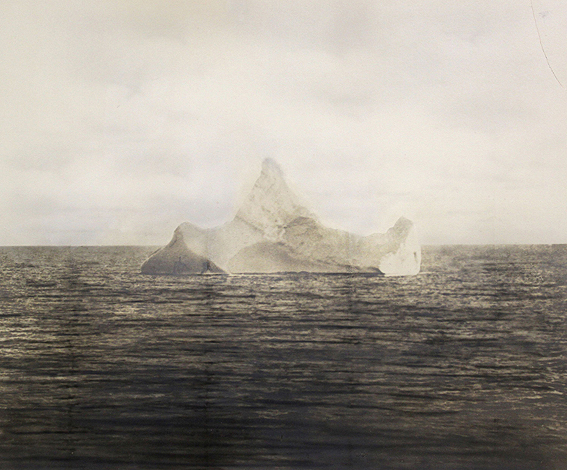
The iceberg photographed from the SS Prinz Adalbert, while is often shown as 'the' Titanic iceberg, is unlikely to be so. (Click image to enlarge)
The most likely candidate, all things considered, is the photograph taken from the Bremen.
Bremen/Rehorek
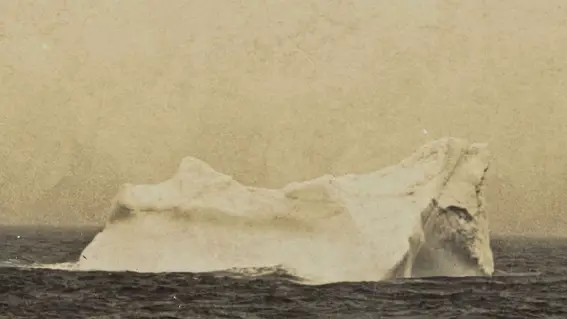
The iceberg photographed from the Bremen is the most likely candidate.
(Click image to enlarge)
The iceberg was photographed on April 20, from the German steamer Bremen by Stephan Rehorek, a Bohemian traveling from Bremerhaven to New York. This is the most likely of the candidates to have been 'the' iceberg - simply due to it matching the eyewitness descriptions and sketches, but interestingly also shows damage in the same area at which the Titanic would have struck.
Titanic seaman Joseph Scarrott described the iceberg at the British Inquiry that "it struck me at the time that it resembled the Rock of Gibraltar looking at it from Europa Point. It looked very much the same shape as that, only much smaller….As you approach Gibraltar - it seemed that shape. The highest point would be on my right, as it appeared to me."
However one aspect of the story raises some suspicion- in Rehorek's postcard to his parents he wrote "I have a photograph of the iceberg and will send it to you (...) I also saw the bodies of the drowned and the wreckage from the ship. It was a dreadful sight." Is it realistic to believe that the iceberg would remain in the same area as bodies and wreckage 5 days after the event?
For more information and analysis check here:
https://www.encyclopedia-titanica.org/the-iceberg-resurfaced.html
Other candidates:
1. SS Etonian/Captain Woods
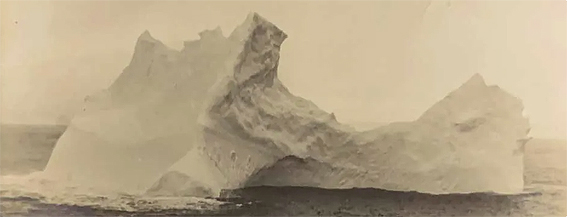
The iceberg photographed from the SS Etonian.
(Click image to enlarge)
The iceberg photographed by Captain Wood of the SS Etonian, taken two days/40 hours before the Titanic's collision. However, as pointed out by Titanic researcher Jim Currie on Encyclopedia Titanica it cannot be the iceberg as "it is the wrong shape as described by AB Joseph Scarrott. Not only that but it was about 7 miles NW of the wreck site and would have to have been almost stationary i.e...had only move that distance in 40 hours. - which is 1074 ft/hour. Furthermore: the Photgraph was taken in Gale conditions. A Gale would have moved an iceberg of that shape a very great distance as long as it was blowing. and in the direction it was blowing." (Encyclopedia Titanica)
2. Carpathia/Bernice Palmer
Acording to the National Museum of American History (Behring Center) "Bernice Palmer took this picture of the iceberg identified as the one which sank Titanic, almost certainly identified by the survivors who climbed aboard Carpathia. The large iceberg is surrounded by smaller ice floes, indicating how far north in the Atlantic Ocean the tragedy struck." (https://americanhistory.si.edu/collections/search/object/nmah_1416178)
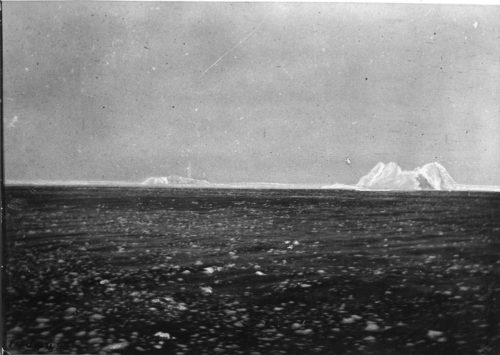
Bernice Palmer's photograph of an iceberg from aboard the Carpathia.
3. Minia/Captain De Carteret
Captain De Carteret of the Minia, a cable ship sent to the wreck site to recover corpses and debris, took this photograph, claiming it was the only iceberg in the area, with red paint on it as a sign it was "the" iceberg.
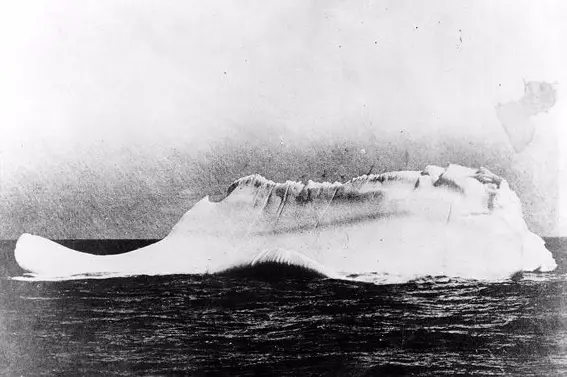
Captain De Carteret of the Minia took this photograph.
4. Birma
The SS Birma was a British-built transatlantic passenger ship that responded to the Titanic's distress calls. It arrived on the scene at 7.30am, although realised they were still 13 nautical miles from where the Titanic actually sank. Captain De Carteret took this photograph of a suspect iceberg.
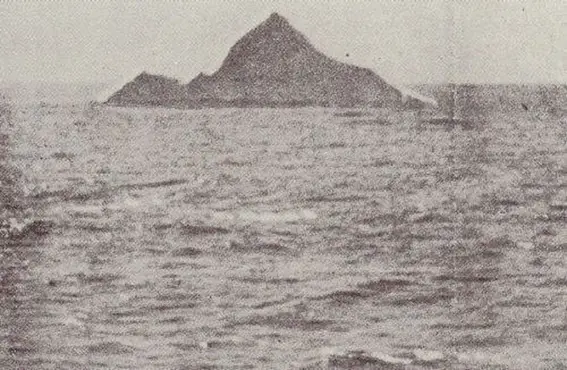
Captain De Carteret of the Minia took this photograph.
5. Carpathia
The distant photographed was allegedy taken on the 27nd of May 1912 - more than a month after the disaster, so is unlikely to be the iceberg in question.
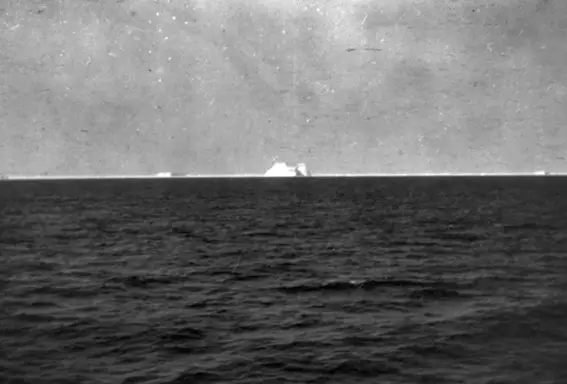
3. Titanic's lifeboats disappeared after December 1912
What remains of Titanic's lifeboats after the disaster is an unsolved mystery. What we do know is that thirteen lifeboats were recovered by the Carpathia: 1, 2, 3, 5, 6, 7, 8, 9, 10, 11, 12, 13 & 16. The remaining lifeboats 4, 14, 15 and collapsibles A, B, C and D were deliberately left to float away after the Carpathia recovered their passengers and were never seen again.
Collapsible A was later recovered by the White Star liner Oceanic on May 13th while en route to New York. Collapsible B was spotted upside down by the crew of the Mackay-Bennett and was also photographed but the crew failed in their attempt to recover it and it was then abandoned. Later the captain of the SS Eisenach spotted a lifeboat in the vicinity 2 months later. It was covered in barnacles, but was not recovered. An unidentified collapsible boat was recovered some 18 months after the loss of Titanic, but it’s unknown if it was one of Titanic’s.
For the lifeboats that were recovered by the Carpathia, they were offloaded at the White Star Line piers on arrival in New York on the 18th of April 1912, before the Carpathia continued on to the Cunard pier. According to researcher Jonathan Smith in his article "DEBUNKING A MYTH: The Southampton Lifeboats Photograph Revealed" - "During the early hours of the morning [19th April 1912] the lifeboats were inspected, the missing contents including flags, name plates and number plaques, were documented and addressed during assessment which was later logged by Brooklyn lifeboat manufacturer C.M. Lane on the 20 April. Under marine laws the lifeboats were required to be checked by officials to establish their value and costs including any repairs needed to base overall evaluation of the crafts."
At some point officials and possibly souvenir hunters had removed anything of value from the boats - such as the bronze plates and plaques, although the lifeboats would still have retained their ID numbers stamped into the timber. Afterwards the 13 lifeboats were put into storage at the White Star Liner berths 58 and 59 between the months of April to December 1912.
The lifeboats were evaluated for their value in September 1912 during a hearing for the United States District Court investigating the liability of the Oceanic Steam Navigation Company, with valuations calculated along with any repairs required to bring a total wrecking cost.: "The Affidavit of Value dated 28 September by marine surveyor Henry H. Masters states that if the lifeboats had not been subjected to damage at the time of his inspection and they included the necessary equipment supplied then the value would have been at $5,700 and a repair cost of $1,180. A second marine surveyor was also called upon who on the same date valued the lifeboats, with all their equipment and without any damage, to the cost of $5,700 with the same repair estimate of $1,180. And so on the 3 October 1912 the lifeboats in the condition upon arrival at New York were considered to be at $4,520 in total. " ("DEBUNKING A MYTH: The Southampton Lifeboats Photograph Revealed", Jonathan Smith).
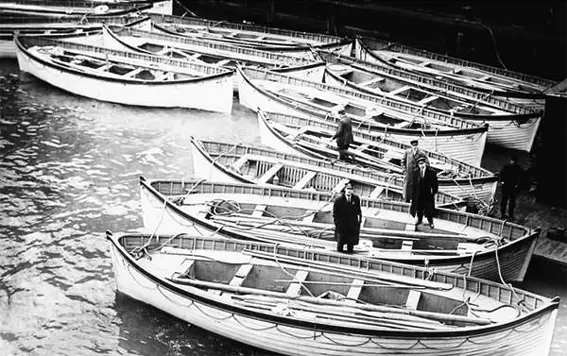
Titanic's lifeboats being examined in New York.
During this time, the Olympic had her number of lifeboats supplemented by additional folding Berthon lifeboats so as to maintain her Southampton-New York service - although initially this was subject to a crew mutiny delaying her first crossing after the Titanic disaster. During the Olympic's refit in October 1912, Titanic's lifeboats were still in New York being evaluated.
The book "Titanic in Photographs" noted that Titanic’s lifeboats were recorded in dry storage of the pier lofts of New York during December of 1912 - while work continued on Olympic. What happened after December 1912 is unknown and subject to speculation. Jonathan Smith surmises that "the case of them ever being used again is highly unlikely for the simple point that they may have been deemed unusable as crafts. … they were not of a type for upgrading or even downgrading for use with other vessels given their dimensions… with the superstitious nature of many in the Edwardian era it was equally bad luck to even consider another use for them. Like Titanic the lifeboats could have been subjected to their own wrecking having been turned to match wood and burned in a unfitting end to erase a sad reminder of one of the worst peace time maritime disasters of its era." ("DEBUNKING A MYTH: The Southampton Lifeboats Photograph Revealed", Jonathan Smith)
More information (Facebook note):
DEBUNKING A MYTH: The Southampton Lifeboats Photograph Revealed
4. Titanic's lifeboats were not put on the Olympic
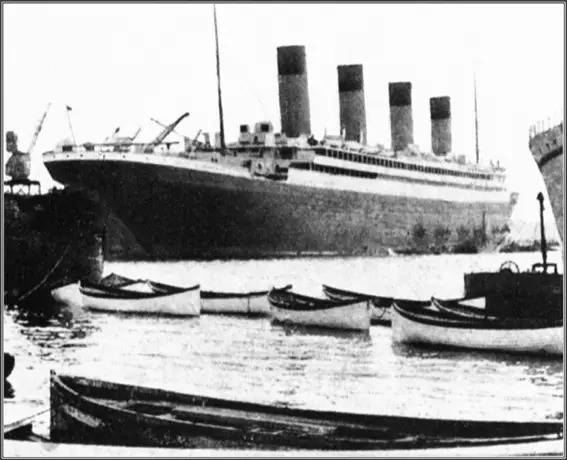
This photograph of the Olympic has erroneously been used to support the idea it was fitted with Titanic's lifeboats.
A photograph showing lifeboats in the foreground has often lead to the assumption that Titanic's lifeboats ended up aboard the Olympic in the summer of 1912, to supplement her limited number after the Titanic disaster. However that theory has been debunked by Jonathan Smith in his article "Debunking a Myth: The Southampton Lifeboats Photograph Revealed" where he notes that the original caption of the photograph does not reference Titanic at all (a glaring omission if it was true) . The photograph is actually showing the H.M.T. Dongola in June 1912 being prepared or a forthcoming annual review "with nine of her lifeboats removed from the vessel and their davit gear as they are cleaned, painted and made ready to be placed back on board for the approaching review." "Debunking a Myth: The Southampton Lifeboats Photograph Revealed", Jonathan Smith)
It makes sense that these are not Titanic's lifeboats - as the Olympic, during her refit that year, included new lifeboats and davits sets - increasing her original June 1911 number from twenty lifeboats to that of sixty-eight overall. So Titanic's 13 old and damaged lifeboats would have been no use for such a refit.
What really happened to Titanic's lifeboats is an unsolved mystery - see the point above.
More information (Facebook group, may require membership):
https://www.facebook.com/notes/titanic-tech/debunking-a-myth-the-southampton-lifeboats-photograph-revealed/2415467501881691/
Back to Top menu
5. Titanic Inquiries were a whitewash
It has been said that the United State Inquiry and British Board of Trade Inquiry were a "whitewash." Certainly that term was used by key witness and senior surviving officer Charles Lightoller. He called the US Inquiry a "complete farce" and admitted that during the British Inquiry "it was necessary to keep one’s hand on the whitewash brush."
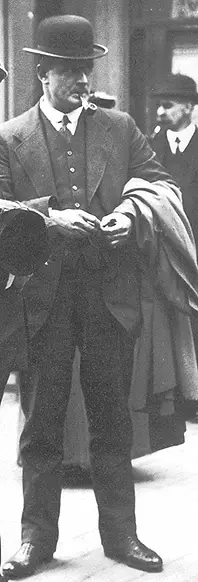
Lightoller photographed during the
British Inquiry, during which he later
admited he had his "hand on the
whitewash brush".
The United States Inquiry was, due to the scope of the disaster, a hurried affair, with the first few days taking place in New York within a day of the survivors arriving - on April 19, 1912, at the Waldorf-Astoria Hotel. The proceedings were later moved to Washington, D.C., concluding on May 25, 1912 with a return visit to New York, taking a total of 18 days. The eight Senators involved in the questioning were not nautical authorities, and Lightoller was annoyed by their lack of expertise. He described the US Inquiry in his book as "a colossal piece of impertinence that served no useful purpose and elicited only a garbled and disjointed account of the disaster; due in the main to a total lack of co-ordination in the questioning with an abysmal ignorance of the sea....With all the goodwill in the world, the ‘enquiry’ could be called nothing but a complete farce, wherein all the traditions and customs of the sea were continuously and persistently flouted." ("Titanic and Other Ships", Charles Lightoller)
In England, an inquiry was instigated by the British Wreck Commissioner on behalf of the British Board of Trade, overseen by High Court judge Lord Mersey, and held in London from 2 May to 3 July 1912. The hearings took place mainly at the London Scottish Drill Hall, at 59 Buckingham Gate, London SW1. There were a total of 42 days of official investigation. Lightoller was once again one of the key witnesses and appeared over the course of 3 days - the 12th ,13th and 14th days of the Inquiry.
His opinion of this investigation was much higher than the US inquiry, but he also admits to having his "hand on the whitewash brush" when he later wrote in his book: "Such a contrast to the dignity and decorum of the court held by Lord Mersey in London, where the guiding spirit was a sailor in essence, and who insisted, when necessary, that any cross-questioner should at any rate be familiar with at least the rudiments of the sea…. [I]n London it was necessary to keep one’s hand on the whitewash brush. Sharp questions that needed careful answers if one was to avoid a pitfall, carefully and subtly dug, leading to a pinning down of blame on to someone’s luckless shoulders.” ("Titanic and Other Ships", Charles Lightoller)
The reason Lightoller called it a "whitewash" is likely two fold: firstly, the Board of Trade investigation was essentially questioning its own safety regulations and hence was unlikely to be overly critical of itself. Secondly, after some embarrassing situations in New York (for example Fifth Officer Lowe falling into the trap of making what were deemed racist comments he later had to apologise for) it is clear that White Star gave their British inquiry witnesses explicit instructions to weigh ever word and not expand unless specifically requested to do so, to avoid the same potential pitfalls that could lead to inadvertantly incriminianting oneself. Lightoller was an outspoken personality but equally, as the senior surviving officer, had also taken on the role of representing the crew. He likely found himself in an unenviable position of wanting to protect the crew, keep White Star lawyers happy while balancing this with the Board of Trade wanting to find blame that was elsewhere from its regulations.
Back to Top menu6. Third Olympic-class ship was unofficially going to be called "Gigantic", officially "Britannic".
It is often said that it was a myth that the White Star Line changed the third ship's name from "Gigantic" to "Britannic" after the Titanic disaster. But that is not entirely true. Essentially, there is unofficial confirmation that the name Gigantic was in use in the newspaper, posters and even in at least two supplier order forms. However, officially, from contract commencement on the 23rd of October 1911 - well before the Titanic sinking - the name had been recorded in the Harland and Wolff ship book as "Britannic" so it seems unlikely it would ever be called "Gigantic" - with or without the Titanic sinking.
Here is a list of various usage of the two names, first unofficially Gigantic, and then officially Britannic:
The Daily Mirror of 16 April 1912:
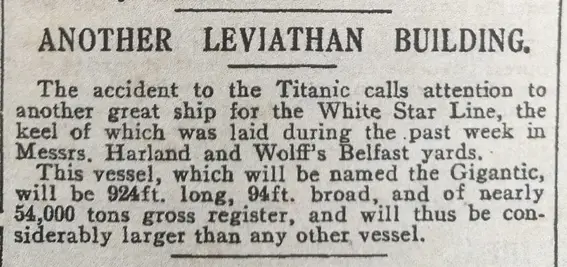
The Daily Mirror of the 1th of April 1912 clearly states that the next "great ship" would be called the "Gigantic".
She was also referred to as “Gigantic” in the Hingley’s order log and in the London and North Western Railway in their quote for transporting the anchor to Harland & Wolff. This means that someone official at Harland & Wolff who placed orders for the yard, contacted Noah Hingley & Sons (the worlds leading manufacturer of anchors and anchor chains and equipment), to place the order for the anchors, chains and equipment for hull number 433 (Britannic) where they used the name "Gigantic" in the order for it to be added to the company order. Also the Citroën company supplier used the name of "Gigantic" and kept using it as far as late 1913.
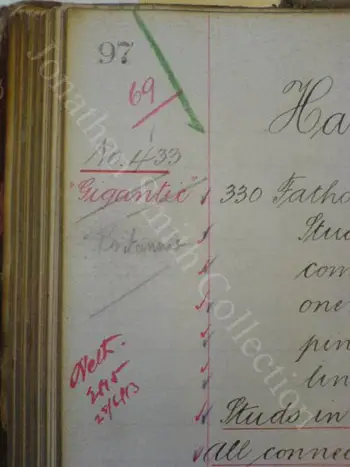
Hingley’s order log, with the name "Gigantic"
(courtesy of TRMA and Jonathan Smith).
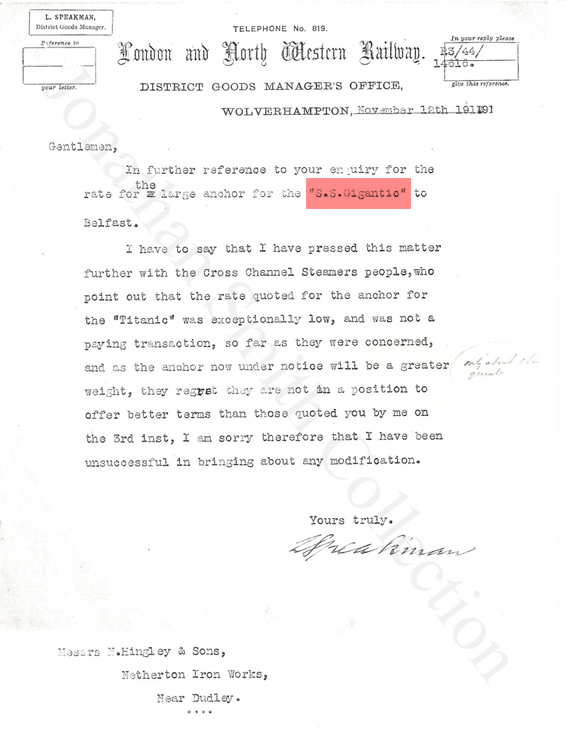
London and North Western Railway in their quote for transporting the anchor to Harland & Wolff clearly uses the name "Gigantic". Courtesy of TRMA and Jonathan Smith.
(Click image to enlarge)
However, as recorded in the Harland & Wolff ship book, which is still preserved in Belfast, the name was Britannic from contract commencement on 23 October 1911.
In summary, it is quite possible that the White Star Line had toyed with the name Gigantic prior to the official contract name of Britannic in October 1911. The name Gigantic does fit within the Greek and Roman mythology which had created the names Olympic and Titanic. But clearly this never became official - perhaps as author Paul Lee points out, "There's also the fact that the names Olympic and Titanic referred to grandeur and size as they were the largest ships in the world when they entered service. By the time 433 was launched, it had been superseded by more massive ships - a fact that would have been known for many years. The name "Gigantic" would not be appropriate."
More information:
http://www.paullee.com/titanic/gigantic.html
http://www.paullee.com/titanic/The_Gigantic_Question_part1.pdf
http://www.paullee.com/titanic/The_Gigantic_Question_part2.pdf
7. Lightoller was involved in the deaths of 36 sailors, but he was not a "war criminal"
There are some who claim Titanic's second officer, Charles Herbert Lightoller, went on to become a war criminal and even call him a "murderer".
Indeed, during world war one, in 1918, Lightoller was given command of the large River-class destroyer HMS Garry. On the 19th June 1918, the HMS Garry, under Lightoller's command, depth charged, rammed and sunk the German U-Boat UB-110, under the command of Kapitänleutnant Werner Fürbringer, off the Yorkshire coast, near the Tyne. There were no survivors of the crew of the UB-110, who numbered 36 all told, but the captain Werner Fürbringer survived. Lightoller subsequently faced criticism over the fact that the crew of the Garry had thrown coal at the survivors of the U-boat and that Lightoller had made no real effort to pick up any of the enemy sailors - he argued that he was more occupied by concerns for his own ship. In 1936 the captain of UB-110 claimed that Lightoller had continued to fire upon members of his crew as they surrendered, killing and spraying machine gun fire onto the hapless men.
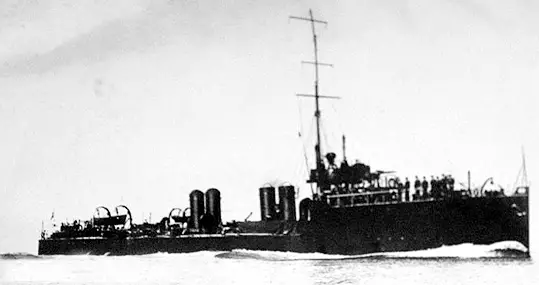
HMS Garry was a Yarrow-type River-class destroyer of the Royal Navy
Lightoller's ill feeling towards the U-boat crew was even expressed in his autobiography, where he does not deny the claims but writes: “Towards the submarine men, one felt an utter disgust and loathing; they were nothing but an abomination, polluting the clean sea.”
However, to be labelled a "war criminal" you have to be sentenced as such. Actually, Lightoller's actions during World War One were investigated and he was cleared and eventually honoured - he was awarded a bar to add to his Distinguished Service Cross, and he was promoted to Lieutenant-Commander. A year later, on July 14, 1919, Lord Sterndale and the Prize Court awarded ₤180 as a bounty for the action they had taken and for the death of 36 German sailors. The money, distributed among the Garry's crew, is equivalent to five pounds for every member of the Kriegsmarine drowned in the incident.
More information here: https://titanicofficers.com/titanic_04_lightoller_11.html
Back to Top menu8. Titanic officers did not experience Titanic 'stigma' in their careers

The four surviving Titanic officers, in a signed studio photograph, on their return to England. It is one of two only known photographs of the officers together. From left: Fifth officer Lowe, Third officer Pitman, Second officer Lightoller and Fourth officer Boxhall. (Click image to enlarge)
It has often been claimed that the four Titanic officers who survived - Second Officer Charles Lightoller, Third Officer Herbert Pitman, Fourth Officer Joseph Boxhall and Fifth Officer Harold Lowe, experienced a black mark against their name due to association with the sinking, resulting in never obtaining their own command.
This alleged 'Titanic stigma' has likely been overemphasised in historical hindsight. The reality in the life and career of an officer is that not every officer can ever, mathmatically also be Captain, with most officers aboard a ship outnumbering the captain from at least 4-to-1, or in the case of Titanic 7-to-1. It was thus not uncommon for even experienced and capable officers to stagnate in their roles. A good example was William Murdoch, who was a very capable officer (unlike most of his colleagues, he never failed a Board of Trade test and skipped his Masters certificate to jump straight to ExtraMasters) and made it to First Officer aboard the Oceanic in 1906 and yet six years later, aboard the Titanic he was still First Officer. This was not due to any failure on his part, but due to a wide range of extenuating factors and especually logistics. Another example is Robert Hume, who was Second Officer aboard the Olympic in 1911, but did not obtain his command until the end of the 1920s.
It must also be noted that three of the four suriving officers were promoted. By the end of their careers both Lightoller and Boxhall had been promoted to Chief Officers, and ultimately were called Commanders (although not via White Star/Cunard). Boxhall also appeared prominently in a large Cunard "On Watch" advertisement in 1937 as a "senior officer" (certainly not a "black mark") wearing three stripes and was variously referred to as "senior first officer" and later "chief officer". Boxhall by 1940 was also "employed as Chief Officer by Cunard White Star - unemployed at present due to continuous ill health, Cunard WS retired him as unfit". So it seems ill health was his demise. While in the case of Lightoller it was impatience - he quit the White Star Line in February 1920, which due to the war did allow enough time for him to have his own command. He quit with the rank of Chief Officer so if he had remained would likely have eventually captained a ship. Lowe was almost immediately promoted from Fourth to Third Officer and retired with the rank of First Officer. In the case of Pitman, failing an eyesight test only months after the sinking, meant he joined the purser's department.
Back to Top menu9. The sinking of the Titanic was not the main contributing factor in the White Star Line's demise
An assumption made by many after learning about the Titanic disaster and the fact that the White Star Line later merged with its rival Cunard in 1934 and then eventually by 1947 had disappeared as Cunard took 100% ownership, was that this was primarily due to the Titanic sinking.
Granted, the Titanic sinking was an expensive affair for the White Star Line. However it had been running at a profit prior to the Titanic tragedy and according to author and historian Mark Chirnside, "Titanic’s financial impact on White Star’s decline vs. Cunard is much exaggerated." He explains that the "White Star remained a significantly stronger company in financial terms in 1912 and afterwards. In my view, the causes were much more long term, stemming from financial mismanagement over three decades as part of IMM and then Royal Mail Group."
The most significant factor in the demise of the White Star Line was not the Titanic - it was that by the 1930s both White Star and Cunard were in serious financial difficulties due to the Great Depression, which had been set off by the stock market crash of 1929. The British government agreed to provide assistance only if the two competitors merged their North Atlantic operations. At the time of the merger the split was Cunard 62% and White Star 38% (as they sold off their Australasian service to Shaw, Savil & Albion also in 1934). Hence it is not surprising that Cunard eventually, as they returned to financial stability, returned to their original name of Cunard in 1950, rather Cunard-White Star.
Back to Top menu10. The scrapping of the Olympic was inevitable
A frequent comment about the Olympic, Titanic's sister ship, is that they shouldn't have scrapped the Olympic in 1935 but instead turned her into a floating hotel, like the Queen Mary.
However, it is an unfair comparison. The Queen Mary was retired in the 1960s...not the 30s (during the Great Depression), so cannot be compared. Interestingly, it was new ships like the Queen Mary in the 1930s that made the Olympic no longer profitable and hence scrapping made economic sense. Only in hindsight, many years later (post Hollywood/1985 Titanic discovery), would keeping her around have ever been considered a good idea.
If you are interested in more information check here: http://www.markchirnside.co.uk/pdfs/RMS_Olympic_Retirement.pdf
At the time the Olympic was scrapped, it was not economically viable to keep her in service or convert her into a hotel. There was very little interest in Titanic to justify it in the 1930s. It was not until the 1950s when books and films began to be produced that interest in the disaster started to develop, of course peaking with the discovery of the wreck in 1985 and then a blockbuster film in the late 1990s.
Back to Top menu11. A violin auctioned in 2013 is - on the balance of probability - Wallace Hartley's

Wallace Hartley's violin on display.
When band master Wallace Hartley's violin was first revealed in 2006 and later put to auction in 2013 it was touted as the "rarest and most iconic" piece of Titanic memorabilia. It for sold for £900,000 in just 10 minutes at auction in Wiltshire. But for some in the Titanic community there has been a large dose of skeptism as to whether it was really found on his body and thus as special as it is made out to be. However if you balance the for and against the conclusion is that it most likely was found along with his body, and hence a genuine artifact:
Against:
* There is no record by the crew of the recovery ship the Mackay-Bennett of any valise containing a violin and sheet music connected to Hartley’s or any other recovered body for that matter. However - we must apply the adage - 'absence of evidence is not evidence of absence.' It is quite possible that the records were incomplete.
* Respected Titanic historians such as Jack Eaton and Charles Haas have expressed scepticism about the ability of a fragile object like a violin to survive the trauma of the sinking. However - we must remember it was inside a case designed to protect it, and the instrument was indeed damaged and unplayable.
For:
* Four newspapers on two continents over several days reported his body being discovered with a "music case" although without specifying its contents.
* A diary entry by his fiancée, Maria Robinson, of 16 July 1912, said a violin was saved from the water and returned to her, with the words: “heartfelt thanks to all those concerned in the return of my late fiancé’s violin”.
* It had taken seven years for the Devizes auction house, Henry Aldridge & Son, to authenticate the instrument, including nine experts.
* Michael Jones, of the United Kingdom’s Forensic Science service and recognised expert in trace analysis concluded on examining the violin that corrosion to its metal parts was consistent with emersion in seawater and was also consistent with the condition of metal objects recovered from other Titanic victims.
* A CT scan revealed that the violin’s shell had two hairline cracks leading down from its F holes consistent with it have been subjected to some trauma.
* Experts in the field of Titanic artefacts and memorabilia, Steve Santini, Craig Sopin and Stanley Lehrer agree with the conclusions of the investigation.
* It is presently on display at the Titanic Museum Attraction in Pigeon Forge, before which it was vetted by historians.
* As one of the most vetted pieces of Titanic memorabilia in history, no one as yet has been able to supply evidence to doubt its authenticity.
A very balanced article about the violin on the UK's Classic FM website is worth reading, and which makes this valid point: "Despite some reports to the contrary, there is no evidence that his violin was found strapped to his chest in its case. We do know, however, that it must have been recovered, along with a satchel embossed with Hartley’s initials, as a telegram transcript from Maria Robinson to the Provincial Secretary of Nova Scotia reads, ‘I would be most grateful if you could convey my heartfelt thanks to all who have made possible the return of my late fiancé’s violin’" In other words, it is quite possible that it was found separately, which is why it is omitted from the description of effects found on his body - simply because it was found separately and thus not included.
For further information:
https://www.classicfm.com/discover-music/instruments/violin/titanic-survived-history/
https://www.encyclopedia-titanica.org/authenticating-the-wallace-hartley-titanic-violin.html
12. Titanic II is unlikely to ever sail but Romandie dry dock one nearing completion
There is often confusion between Clive Palmer's "Titanic II" and the Chinese Romandisea Titanic. They are two entirely different projects:
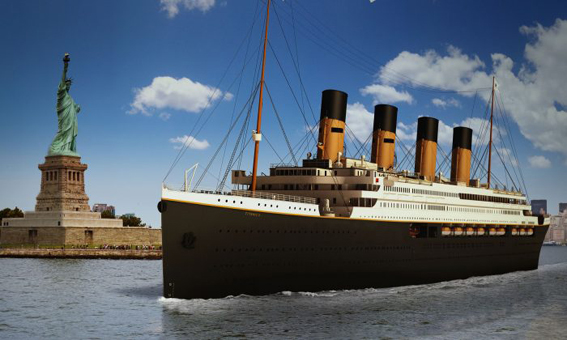
"Titanic II" is unlikely to never become a reality.
"Titanic II" was planned by Australian millionaire Clive Palmer under the name "Blue Star Line". Initially announced in 2012, the US $500-million project was meant to see the ship launched in China in 2016, with a cruise from Dubai planned for 2018. This did not happen and it was anounced in 2018 that it will still cruise from Dubai in 2022 - but construction still remains to begin. Many believe is unlikely to ever happen.

The landlocked Romandisea replica is still under construction (as of 2021).
The Romandisea Titanic is an under-construction full-scale replica of the original RMS Titanic, located in landlocked Sichuan province, China. It was originally planned to be completed in 2017, but delays mean it is presently, as of 2024 still under construction.
More information: https://en.wikipedia.org/wiki/Romandisea_Titanic
Back to Top menu13. The 1997 film is not exactly the same duration as the sinking
A popular meme of the 1997 "Titanic" film is the following:
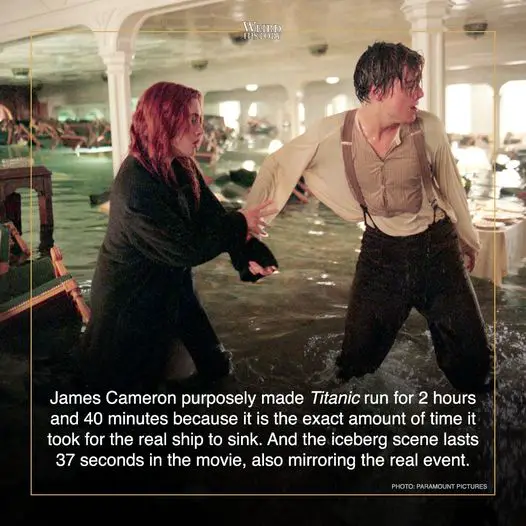
This meme is patently false.
Neither of the statements in the meme is correct. Firstly, the facts: the Titanic stuck the iceberg at 11:40pm and sank at 2:20am, a sinking duration of 2 hours 40 minutes.
The 1997 film's total running time is 3 hours 15 minutes - so is actually *longer* than the time the Titanic took to sink. The iceberg collision scene is also 2 minutes 12 seconds long - not 37 seconds. From collision to sinking it is 1 hour 4 minutes. The closest to anything in this meme being accurate is the ship sinks at the 2 hours 44-minute mark - which is almost the same time it took for the ship to sink.
Back to Top menu14. The 1997 film was more expensive than building the ship
When allowing for inflation, James Cameron's 1997 film - with a budget of $200 million (originally $110 million), was indeed more expensive than the cost of building the ship ($7.5million) in 1912.
As of 2024, inflation calculators only operate from 1913 onwards, but state the following:
U.S. Inflation Calculator (https://www.usinflationcalculator.com/)
7,500,000.00 in 1913 is $121,590,909.09 in 1997
(Cumulative rate of inflation: 1521.2%)
Inflation Calculator with U.S. CPI Data (https://www.calculator.net/inflation-calculator.html)
$122,831,632.65 in 1997 (Average) equals $7,500,000 of buying power in Jan. 1913.
It is worth pointing out that a budget-to-budget comparison does not allow for changes to shipbuilding methods, safety regulations and supply of materials, all of which would likely increase the cost of construction. As a case in point, the Oasis Class of the Royal Caribbean features the four largest cruise ships ever built, with the average price over $1 billion each to build (for example Symphony of the Seas, launched in 2016, cost $1.5 billion). It is also interesting to also note that the film's budget of $200 million does not include its marketing budget - estimated at more than $50 million. But similarly, the cost of running Titanic, its preparation, crew and supplies would also have cost more. A notable difference is that the 1997 film went on to make a box office profit of $1.4 billion.
Back to Top menu15. The 1997 film does not make First Officer Murdoch a "villain"
In James Cameron's 1997 film, First Officer William Murdoch is portrayed as accepting a bribe from fictional character Caledon Hockley, shooting a passenger and then shooting himself. This was picked up by the media who subsequently labeled Murdoch a "villain" and criticised Cameron's portrayal.
The reality is that it was not Cameron's intent to make Murdoch a "villain". In the "making of" book published in 1997, "James Cameron's Titanic", on page 129, Cameron is quoted as saying: "Murdoch was an honorable man burdened by the responsibility for the impending deaths." In another part from the book he adds: "I’m not sure you’d find that same sense of responsibility and total devotion to duty today. This guy had half of his lifeboats launched before his counterpart on the port side had even launched one. That says something about character and heroism” (James Cameron’s Titanic, p.129)
It is also noticeable that Murdoch throws the bribe money back at Cal and, notably, at the very end scene, the grand staircase "dream" sequence, has Murdoch standing next to Thomas Andrews, smiling as Rose drifts by and clapping along with the rest of the crowd of happy onlookers as Rose and Jack kiss. This is further evidence of Cameron's respect for Murdoch (in contrast neither Cal nor his manservant appear in this end scene).
While there is no evidence of any bribery - a fictional dramatisation - it must also be noted that an officer shooting passengers and then himself is supported by a vast array of eyewitness accounts. As the key historical adviser on the film, author Don Lynch was quoted by fellow author George Behe as stating: "I have continually defended Jim’s right to put that scene in the movie since there is not proof that the suicide didn’t happen, despite my feelings that it didn't." For more information on the shooting/suicide accounts please check here: https://www.williammurdoch.net/mystery.html
In reality, the "villain" label, and the Murdoch-family-upset-apology was mostly media exaggeration, in an effort to create a lucrative story that does not accurately reflect Cameron's intent. As for "upset" living family, there was only one distant family member - Samuel Scott Murdoch - and by all accounts had never even watched the film. For more information please check here: https://www.williammurdoch.net/articles_03_dalbeattie_apology.html).
F. Wreck
1. The exact location of the wreck site is established.
There are some who claim that the location of the wreck is a secret. However it has been established: the location of the centre of the 5 boilers is 41°43.5″N 49°56.8″W.
For more information check Sam Halpern's website:
http://www.titanicology.com/DauntsRocktoCollision.html
2. The Titanic was possibly discovered before Dr Robert Ballard's official discovery in 1985
According to the official story, the Titanic was discovered on the 1st of September 1985 by Dr.Robert Ballard of the Woods Hole Oceanographic Institute in a joint French-American expedition with Jean Louis-Michel of IFREMER (The French Institute for the Exploitation of the Sea).
There are some anomalies in the story about how the Titanic was found - notably a Sunday London Observer newspaper article announcing the discovery the day before it was official found.
According to research by author Dr Paul Lee, it is possible that actually the Titanic was first spotted by a Royal Navy vessel, the HMS Hecate, in 1977. Classified reports are due to be released in 2027 - when perhaps the truth will be known.
For more detailed information check here:
http://www.paullee.com/titanic/titanicfound.html
3. The Titanic discovery was part of a undercover Navy operation
On June 2nd, 2008 National Geographic broke the news that the 1985 discovery of the Titanic stemmed from a secret United States Navy investigation of two wrecked nuclear submarines, the U.S.S.Thresher and U.S.S.Scorpion. to discover the fate of the nuclear reactors that powered the subs. Completing the Navy mission Ballard had just 12 days left over to find Titanic.
More information:
https://www.nationalgeographic.com/history/article/titanic-nuclear-submarine-scorpion-thresher-ballard
https://www.nationalgeographic.co.uk/history-and-civilisation/2018/11/titanic-was-found-during-secret-cold-war-navy-mission
4. Shoes are not necessarily where bodies lay
There are several images of shoes on the sea floor with captions indicating that these shoes are all that are left of a body that has disintegrated. Often such images are used when promoting anti-salvage opinions about the wreck.
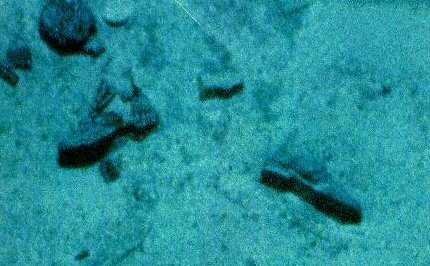
This image from the Titanic wreck site often leads people to believe
a body once lay in this position.
However on closer examination the shoes may not actually be a matching pair and some are clearly from suitcases or bags that have since disintegrated, leaving the remains of packed clothing and not necessarily bodies.
The New York Times acknowledges: "Scholars say most of the people who died were probably in life jackets and swept far to sea by wind and waves. After the sinking, a storm blew up that was reported to have scattered bobbing corpses in a line 50 miles long." (Source: https://www.nytimes.com/2012/04/15/science/titanic-may-hold-passengers-remains-officials-say.html
Author Joe C Combs 2nd has researched the photographs and concludes: "To many, every shoe represents a body that was on the ocean bottom with the Titanic. This is not true….Those who claim a body for every shoe are jumping to conclusions without investigating the facts."
For example, for the most famous photograph released at the time of the discovery by Dr Robert Ballard, Combs notes that "some even going as far as to say these shoes were on a body that disintegrated. If that were true they would fsten the same way, the left shoe fastens on the outside of the shoe and the right shoe does not. Not a normal way of fastening shoes, Shoes either slip on, fasten infront, or BOTH shoes fasten on the outside."
Other photographs have similar anamolies, such as a heel of different heights,and an "angle of these shoes to each other makes it doubtful there were feet in them while they were laying like this."
Combs has a more logical explanation as to what happened to most bodies: "Titanic had 3,560 life vests on board, more than the number of people the ship was allowed to carry, certainly more than the 2200 people on board.…A cork life vest, like those on Titanic, when submerged in water for 48 hours only gains 3% weight from water. There was a current to the south of about one knot (one nautical mile), in 48 hours a person from Titanic in a life vest in the water would have floated about 48 miles south of Titanic. The last person found floating from Titanic was found, in a life vest, hundreds of miles from where Titanic sank 6 weeks after Titanic sank. The people in life vests, by the time those life vests became water-logged, would have sank to the ocean floor far from the site of Titanic wreckage.
Titanic Shoes: Myth & Reality:
https://joeccombs2nd.com/2012/04/29/titanic-shoes-myth-reality/
5. Wreck cannot be raised
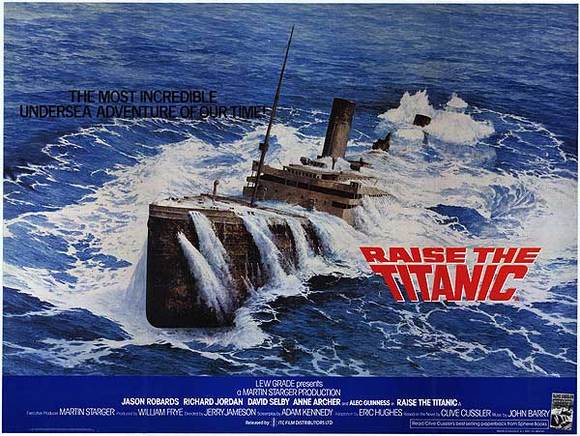
Unlike what is portrayed in the 1980 film, the Titanic wreck cannot be raised.
While a fictional film showing the Titanic being raised to the surface was released 5 years before the discovery of the actual wreck, the reality is that the wreck is too deep, in too many pieces and too fragile to be raised.
Over the years there has been many mostly outrageous ideas as to how to raise the wreck - electromagnets, balloon filled with helium, filling it with wax, vaseline or ping-pong balls or floating glass spheres, or even freezing the seawater around it with liquid nitrogen to turn the wreck into an icecube.
However since the Titanic split at the surface, the wreck is in two pieces - the bow and stern, with its mid section spread inbetween, so could never be raised in tact. Overall the wreck is in a heavy state of decomposition and extremely fragile. It also lies 12,500 feet in an inhospitable environment, covered in "rusticles" and prone to fast and destructive currents.
Nevertheless, a large section of the hull, named the "Big Piece" was indeed raised to the surface in 1998 by RMS Titanic Inc. - and will be the closest we get to raising the Titanic.
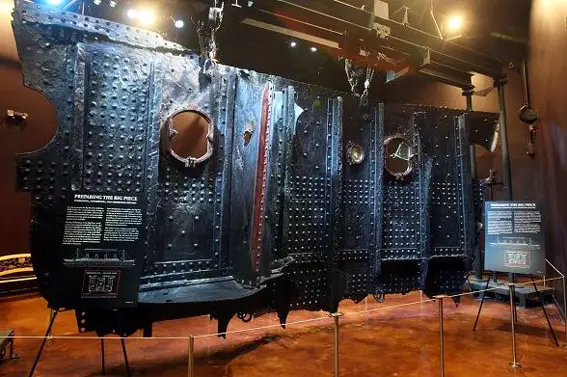
While the Titanic cannot be raised - a section of her hull was brought to the surface, dubbed the "Big Piece."